
Rural roots Pioneer families support county
fairs


fairs


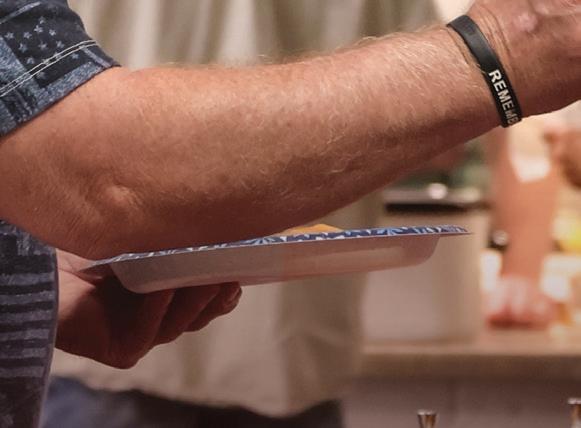










As your not-for-profit electricity provider, we are your energy community. The power we provide does much more than keep the lights on; it plugs into the family, friends, and neighbors who make up your local electric cooperative.




As Superman again soars across movie screens the world over, Cleveland, the city where he was born, is finally reclaiming him.
While classic Lyman watercraft still cruise Ohio’s waters, new ones are on the prowl for the first time since the last century.
The ancient art of paper quilling can be a different way to scratch that creativity itch.
Cover image on most editions: David Corenswet stars as the Man of Steel in DC Studios’ Superman, which opens in theaters this month. Much of the movie was filmed at familiar locations in Cleveland, where the creators of the iconic comic-book hero grew up (image courtesy of Warner Bros. Ent./DC Studios).
This page: Ohio's quilling enthusiasts create designs using spirals of paper, an art form popular in Europe during the Renaissance.

Independence Day is a special time for Ohioans to honor the courage and hard work of our founding fathers, who overcame great struggles to create a nation where values like liberty, personal freedom, and self-governance could thrive. These same values continue to guide how Ohio’s electric cooperatives operate today.
Facing today’s energy challenges
Demand for electricity in Ohio and across the country is growing quickly as new technologies, factories, and data centers all require more and more power all the time. Unfortunately, it’s only going to get more difficult to meet that demand, as many reliable power plants that run on coal or natural gas have been targeted to close before the end of their useful lives — and new power plants are not being built fast enough to replace them.
While these challenges may not compare to what the founders faced in the struggle for independence, we should be inspired by their example, using teamwork, smart planning, and determination to make sure that electricity stays reliable and affordable for the future.
The government’s role in energy
President Reagan famously said that government “help” can be terrifying, but the truth is that the government plays an important role in how the electric utility industry operates. Regulations are needed to keep the power grid stable and ensure electricity is always available and affordable, and it seems as if the current administration is actively working to both revise existing rules and establish new ones that will enable our industry to meet the nation’s energy needs.
Your co-op is ready
Ohio’s electric cooperatives are prepared to handle the challenges that lie ahead. We have enough power generation to serve our communities — with some room for growth — and because cooperatives are run by their members, we can make smart decisions about adding new resources when needed.
As we celebrate Independence Day, it’s important to think about the values that helped build our country, because it’s these same values that guide your co-op as we work to create a stronger future for our members. Remember, Independence Day is not just about remembering the past — it’s also about committing to a better tomorrow.
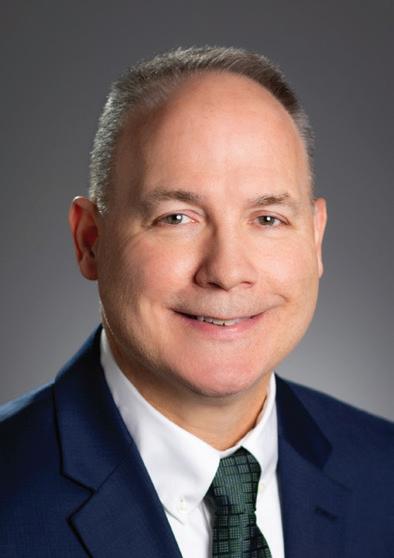
Craig Grooms PRESIDENT & CEO OHIO’S ELECTRIC COOPERATIVES
President Reagan famously said that government ‘help’ can be terrifying, but the truth is that the government plays an important part in how the electric utility industry operates.
Ohio Rural Electric Cooperatives
6677 Busch Blvd. Columbus, OH 43229 614-846-5757 www.ohiocoopliving.com
Craig Grooms President & CEO
Caryn Whitney Director of Communications
Jeff McCallister Senior Managing Editor
Amy Howat Assistant Managing Editor
Neal Kindig Graphic Designer
Contributors: Margaret Buranen, Colleen Romick Clark, Getty Images, W.H. “Chip” Gross, Jill Moorhead, Jamie Rhein, Catherine Murray, James Proffitt, and Damaine Vonada.
OHIO COOPERATIVE LIVING (USPS 134-760; ISSN 2572-049X) is published monthly by Ohio Rural Electric Cooperatives, Inc. It is the official communication link between the electric cooperatives in Ohio and West Virginia and their members. Subscription cost for members ranges from $6.48 to $7.92 per year, paid from equity accruing to the member.
POSTMASTER: Send address changes to editorial and advertising offices at: 6677 Busch Boulevard, Columbus, OH 43229-1101. Periodicals postage paid at Berne, IN 46711, and at additional mailing offices. Nothing in this publication may be reproduced in any manner without written permission from Ohio Rural Electric Cooperatives, Inc. All rights reserved. The fact that a product is advertised in Ohio Cooperative Living should not be taken as an endorsement. If you find an advertisement misleading or a product unsatisfactory, please notify us or the Ohio Attorney General’s Office, Consumer Protection Section, 30 E. Broad St., Columbus, OH 43215. Periodicals postage paid at Columbus, OH, and at additional mailing offices.

Demanding: Advancing technologies — data centers in particular — present co-ops with a new and unique set of challenges.
Smokey’s house: Fire towers once watched over the forests of Ohio and the nation.
Butterfly celebration: A Hocking Hills couple turns their family land into a nature conservation center.
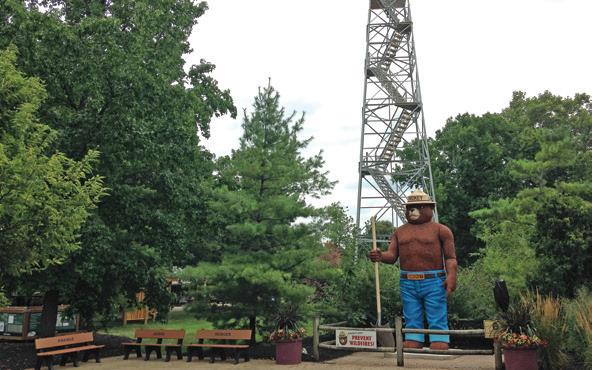

15
Red, white, and chew: Serve some patriotic fun for your holiday gathering.

19
News and other important information from your electric cooperative.
What’s happening: July/August events and other things to do around Ohio.
National/regional advertising inquiries, contact Cheryl Solomon
American MainStreet Publications 847-749-4875 | cheryl@amp.coop
Cooperative members: Please report changes of address to your electric cooperative. Ohio Cooperative Living staff cannot process address changes.
Alliance for Audited Media Member

We all scream for ice cream! What’s better on a hot summer day than a cold, melty treat? At right, Consolidated Cooperative member Robin Snow’s daughter, Candice, and grandchildren, Landon and Lillian, enjoy the flavor of the month.


The ever-increasing need for power presents both challenges and opportunities for electric co-ops and their members.
BY JEFF MCCALLISTER


Near New Albany, within about three miles of one another, stand three buildings — modern but rather plain and, but for their size, could even be described as nondescript. But you can hardly overlook the high-voltage power lines that dominate the space next to them.
They are data centers, giant buildings full of computers — one is owned by Google, one by Meta (the parent company of Facebook), and the other by Amazon Web Services. And they are far from unique. Even a quick online search shows no fewer than 50 such sites within a 50-mile radius of those three and more than 100 in the state. Many of those are in larger cities, but more and more sit on what, until recently, was rural farmland.
They are also super-sized users of electricity. According to the U.S. Department of Energy, data centers can consume as much as 50 times the energy per floor space as other types of commercial buildings. By themselves, each of those three centers near New Albany draws more power from the grid at any given moment than most of Ohio’s 24 local electric cooperatives draw at their peak
Data centers are the backbone of the internet. They store and manage everything from social media accounts to streaming services and internet shopping. When you do a Google search on your phone, it goes through a data center — and if that search uses AI, it takes up to 10 times more electricity than a regular search. Wonder what it means to have your photos stored “in the cloud?” They are here.
Data centers already account for nearly 4% of the electricity use in the midwestern U.S. With AI demanding more and more power, forecasters predict that will grow to 12% by 2030 and 16% by 2039
“Data centers are one of the biggest disruptors of electric grid operations in the last century,” says Ben Wilson, assistant vice president of power delivery engineering for Buckeye Power, the co-op-owned generation and transmission cooperative that provides power to Ohio’s 24 local electric distribution cooperatives. “There’s just an unprecedented amount of new demand coming online, and we are all, as an industry, trying to come up with a satisfactory answer on how it's all going to shake out.”
In Ohio specifically, the state’s peak electricity consumption is about 30,000 megawatts. American Electric Power, which owns the transmission lines that bring high-voltage electricity to much of the southeastern and central parts of the state, says it has agreements with various data companies to add 5,000 megawatts of load in Central Ohio alone — which would nearly max out the capacity of its existing
Continued on page 6



transmission system. More transmission lines capable of carrying that much power can be built, though that traditionally takes a minimum of seven to 10 years.
And AEP alone has requests from other companies wanting to build new data centers that combined would use more energy than the current total load in the entire state. Ohio’s other investor-owned utilities and transmission carriers are in similar positions.
Since data centers hold so much sensitive electronic equipment, those facilities need not only a large quantity of power but also a supply that is steady and reliable. That means they can’t necessarily count on intermittent sources such as wind or solar. Instead, they need baseload generation — that always-available electricity provided by facilities like Buckeye Power’s Cardinal Plant.
Ohio co-ops focus first and foremost on the needs of their members, and so far, there are no mega-load data centers being served by Ohio co-ops. The prospect of attracting such a project, however, is intriguing — for most of Ohio’s co-ops, even a medium-sized data center would consume more power at any one time than the rest of its members combined.
Data centers bring numerous potential benefits to local communities — they create jobs, especially during construction; spur improvements to roads, bridges, and other infrastructure; and increase the local tax base.
Serving a data center, however, is not without risks. The up-front investment to upgrade needed equipment to serve the project would be significant, and if a data center would later shut down or relocate, those bills would still need to be paid.
Also, beyond that revenue stream, data centers bring only limited benefits to the communities
where they’re located in terms of permanent jobs or supporting businesses development. And because of recently passed legislation that could allow data centers to generate their own power, even that enticing revenue stream may not be what it seems.
All that power demand creates other problems as well, because at the same time demand is growing so quickly, always-on sources of power are facing pressure to close. The U.S. Energy Information Administration expects coal-fired generation nationwide to drop to half of today’s levels by 2030, and that growing imbalance could threaten electric utilities’ ability to reliably keep the lights on.
That’s why co-ops’ member focus is so important. “Ohio's co-ops are on good, solid footing in terms of having sufficient generation capacity to serve their existing members.” says Buckeye Power CEO Craig Grooms. “If a mega-load data center wants to locate in co-op territory, we are equipped to support it. Of course, we’ll implement strong risk-management practices to safeguard against potential cost increases that may arise due to the substantial infrastructure investments.”

The dark blue and the green areas represent the amount of power generation expected to be available from thermal and renewable sources in the coming years — an overall reduction as more thermal resources such as coal-burning power plants are retired. The pink lines, on the other hand, represent forecasts of how much generation will be needed as more data centers come online and more of everyday life is electrified. At the current rate, demand will overtake supply within two to three years.
A er decades of flat or declining electricity demand, the United States is in the midst of a boom in power use. Recent government data shows that power consumption nationwide is set to increase by at least 38 gigawatts between now and 2028. This trend would ordinarily be great news for the power industry. But government policies aimed at shutting down fossil-fuel-based generation and years-long delays in permitting and siting for new transmission lines are turning this power boon into a capacity crisis. Here are the primary demand drivers:
Electric vehicle adoption, electrification of home heating and industrial electrification are expected to increase overall U.S. energy consumption by 1% per year through 2026.
Driven by explosions in artificial intelligence, cryptocurrency and cloud computing, total U.S. data center load is projected to increase by 65% by 2050.
Residential power consumption is expected to increase by 14% to 22% through 2050 due to increases in population and steady economic growth.
New, expanding and “onshored/reshored” manufacturing capacity driven by federal incentives is expected to increase industrial demand by 13,000 GWh per year.
Analysts predicted in 2023 that U.S. peak demand will increase by at least 38 GW over the next five years, nearly double the growth rate predicted in 2022.





















The Natural Resources Park at the southeast corner of the Ohio Exposition Center (also known as the state fairgrounds) is an 8-acre oasis in what is otherwise a vast sea of concrete.
If you’re planning to attend the Ohio State Fair, July 23 to August 3, you really should stop by. And if you have young children in tow, the 15-foot-tall animatronic Smokey Bear is sure to be a hit. The very bright bruin somehow mysteriously knows the identity of the boys and girls strolling past with their parents and greets the kids by name.
Smokey, of course, is best known as the star of the longest-running public service announcement campaign in American history, cautioning people since 1947 on behalf of the U.S. Forest Service to “remember ... only YOU can prevent forest fires.”
That’s why it’s appropriate that standing behind the giant Smokey at the state fairgrounds is a second icon of Ohio forest management history: the 60-foot Armintrout Fire Tower.
At least 48 fire towers once stood on state, federal, and private lands across the Buckeye State — 39 of which were operated by the Ohio Department of Natural Resources Division of Forestry. The first, Copperhead Fire Tower, was erected at Shawnee State Forest in 1924. The last one in use, Green Ridge at Pike State Forest, closed 56 years later in 1978 as aircraft became more commonly used for wildfire detection.
The retired Armintrout tower was relocated from Pike County to the state fairgrounds in 2016.
Fire towers are memorable not only for the important purpose they once served, but also for the people they attracted to staff them as lookouts. Years ago, the outdoors humorist Patrick McManus wrote an article for Sports Illustrated titled “Wild Life in a Room with a View,” in which he described the types of people who applied for the federal jobs.

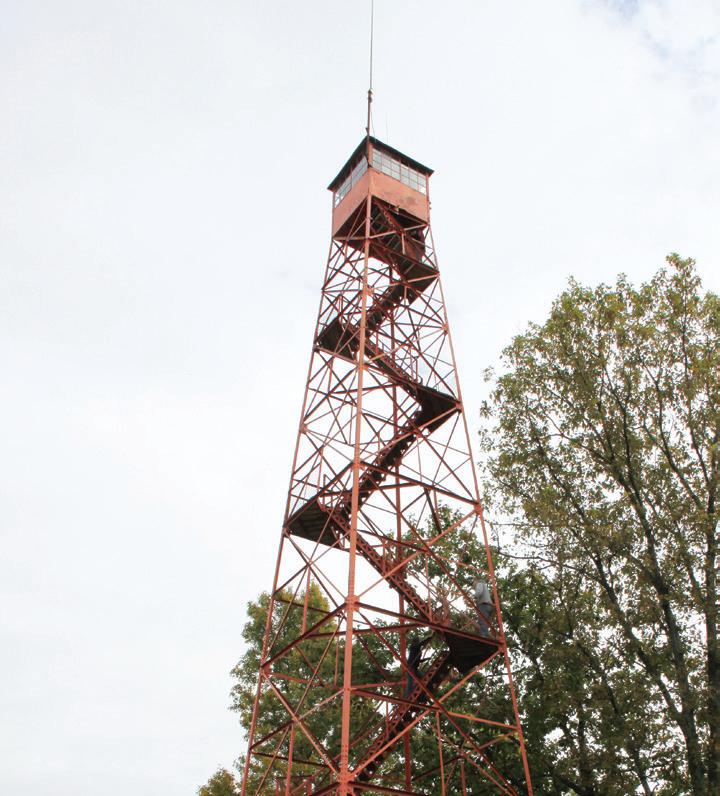
“The experience of the Forest Service suggests that no particular kind of individual is ideally suited to life in a tower suite, and the recruits who show up for training early each summer prove to be a strangely mixed lot: prim lady schoolteachers, college professors, ministers’ wives, loggers, vacationing businessmen, farmers, grandmothers, coeds, honeymooners, old marrieds, beauty queens, students, female truck drivers, ex-marines, and cookie-baking housewives; in short, just about anyone who can shake off the fetters of routine life for three months.”
The candidates also may or may not have possessed much experience or knowledge about the outdoors. For instance, McManus related the story of one fire tower lookout who nervously radioed his supervisor that “big, hairy beasts are ganging up around the foot of my tower.” Going outside for another check, the lookout quickly ran back to the radio yelling, “Now they’re coming up the stairs!” Fearing the worst, the supervisor jumped in his pickup truck and raced to the fire tower, only to find a family of pack rats playing on the lower levels of the stairway.
But there were legitimate dangers. Fire towers were equipped with lightning rods, yet could still be hit by lightning, producing an effect much like sitting inside an exploding bomb. “Rangers consider the first lightning storm as the qualifying exam for their new lookouts,” McManus wrote. “Up to then, they’re amateurs. After it, they’re pros.”
One particular lookout qualified as a pro during his first night on the job, his tower being struck by lightning nine times! McManus wrote, “Asked if he would like a few days off to pull himself together, the lookout said no, he would stick to his post — an obvious case of shell shock.”

In addition to the Armintrout Fire Tower at the state fairgrounds, nine others remain in the state; seven are owned by the ODNR Division of Forestry and two are owned by the U.S. Forest Service:
• Ash Cave: Hocking Hills State Forest
• Atkinson Ridge: Zaleski State Forest
• Blue Rock: Blue Rock State Forest
• Brush Ridge: Tar Hollow State Forest
• Copperhead: Shawnee State Forest
• Mohican: Mohican-Memorial State Forest
• Scioto Trail: Scioto Trail State Forest
• Snake Ridge: Wayne National Forest Headquarters, Nelsonville
• Shawnee Lookout: Hocking County

W.H. “Chip” Gross is Ohio Cooperative Living’s outdoors editor. Email him with your outdoors questions at whchipgross@gmail. com. Be sure to include “Ask Chip” in the subject of the email. Your question may be answered on www.ohiocoopliving.com!
www.ohiocoopliving.com


Couple turns family land in the Hocking Hills into a nature conservation center.


STORY AND PHOTOGRAPHS BY JAMIE RHEIN
The 21-acre slice of the Hocking Hills on State Route 374, about halfway between Pine Creek and Laurel Run southeast of Rockbridge, has been in Christopher Kline’s family since 1863. The once-vast acreage was gradually parceled out to family members as it was passed down through generations, and Kline has fond memories of visiting his grandfather, who farmed strawberries, potatoes, and corn on this particularly pristine patch of paradise.
“My grandpa quit farming as he got older, but he still mowed the agricultural field for a long time,” Kline says. “He finally grew tired of messing with the hill.”
When Kline and his wife, Kris, members of Lancasterbased South Central Power Company, acquired the land, they weren’t sure exactly what they were going to do with it.
“We could cut for timber, but that didn’t seem fulfilling,” he says. Finally, they decided to fall back on what they know. Christopher has a master’s degree in plant biology from Ohio University and served as education director at the Grange Insurance Audubon Center in Columbus. He also was interpretation
specialist at Franklin Park Conservatory, where he was known as “The Butterfly Guy.”
“I know butterflies, and we both know how to educate,” he says. They decided to create a place centered on the well-being of southeastern Ohio butterflies, and soon enough, Butterfly Ridge was born, with a mile-long trail winding through a variety of butterfly-friendly habitats.
Worn-out farmland became pollinator-heavy prairie. Overgrown woods became havens as a threedimensional checkerboard of forest openings was carved out. Wetlands were tamed with a boardwalk. A tree house presents high-level views of all of it.
Butterfly Ridge is one of 14 stops on the Hocking Hills Butterfly Trail. Maps and passports are available at the Hocking Hills Regional Welcome Center in Logan, or they can be downloaded at www.explorehockinghills.com/hocking-hillsbutterfly-trail.



Butterflies may be the headliner at Butterfly Ridge, but at night, moths take center stage. Each Saturday from June through August, owners Christopher and Kris Kline illuminate bright white backdrops that draw ’em in like, well, like moths to a flame. Look for polyphemus, silk, rosy maple, imperial, and cecropia moths among the night visitors.

Bees are also part of Butterfly Ridge’s repertoire, and visitors will find a pollination display with fascinating bee and pollination facts (like, there are 200,000 pollinator species around the world and 20,000 of them are bees).
Flora is a vital part of the butterfly-attracting scheme, and markers help visitors identify the plants that are particularly popular with fluttering friends. Bird’s-foot violets, plantain orchids, and downy rattlesnake plants dot the edges of the trail and lace the ground through the trees. As butterfly season peaks, wild bergamot and purple coneflowers bloom. “We’re big fans of native Ohio thistle, bush clover, mountain mint, and sneezeweed — and the little native bees love it, too,” Kline says.
Visitors to Butterfly Ridge can look for the small white Henry’s elfin butterfly in early spring. The flutters of yellows, oranges, browns, and blacks of the silver-spotted skipper, eastern tiger swallowtail, little wood satyr, and eastern comma are later arrivals (butterfly guides are available in the gift shop).
Butterfly sightings are not guaranteed for visitors, though, even during peak butterfly seasons from late
May to early June and late July to early August. Rain, cloudy days, and temperature fluctuations can influence butterfly appearances.
“To me, that’s the fun thing,” Kline says. “You walk the trail and you don’t know what you’ll see. The way I look at it, we are like a butterfly safari.”
If butterflies are shy when you visit, it’s still a beautiful place to just come and experience, and visitors can gather a bevy of butterfly know-how. In fact, helping people become environmental stewards is an important part of Butterfly Ridge’s mission. “One of our big things is giving out information so people can steal our ideas and make a butterfly garden themselves.”
Butterfly Ridge, 17864 State Route 374, Rockbridge. 740-204-5372; www.butterfly-ridge.com.



$5 Gold American Eagles at COST! It’s that simple. These Government issued coins are the easiest and safest way to protect your money and your family! A five minute call can change everything. DON’T WAIT! If you are buying as an



Serve some patriotic fun for your holiday gathering.
Prep: 15 minutes | Bake: 20 minutes | Chill: 1+ hours | Servings: 12
1½ cups flour
½ teaspoon baking powder
½ teaspoon baking soda
¼ teaspoon salt
½ cup butter, softened
½ cup packed brown sugar
FROSTING
4 tablespoons butter, softened
1+ cups powdered sugar*
½ teaspoon vanilla

½ cup sugar
1 large egg
1 teaspoon vanilla
½ cup semi-sweet chocolate chips
¼ cup red and blue M&M candies
1 tablespoon meringue powder or cornstarch (optional)*
1+ teaspoons milk or cream*
In a small bowl, mix together flour, baking powder, baking soda, and salt. Set aside. In a large bowl with mixer on medium speed, beat butter, brown sugar, and sugar until light and fluffy. Add egg and vanilla and beat until combined. Add flour mixture (beating slowly at first) until just combined. With a spatula, fold in chocolate chips.
Preheat oven to 350 F. Grease a 10-inch round springform pan; evenly press dough to the edges. Sprinkle with M&Ms, lightly pressing them into dough. Bake 18 to 20 minutes, until golden brown. Cool to room temperature on a rack. Meanwhile, make the frosting: Beat butter until fluffy, then mix in powdered sugar and vanilla until smooth. Add a bit of milk or cream for ease of piping.
Run a butter knife along the inside edge of the springform pan to loosen. Unlock springform and remove the side of the pan.
Pipe frosting around the edges. Place cookie in an airtight container in the fridge. Chilled cookie should be easy to remove from springform base. Slice into wedges to serve.
*To prevent buttercream from melting on hot summer days, increase the amount of powdered sugar or mix in a tablespoon of meringue powder or cornstarch, and a bit of milk or cream for easier piping.
Per serving: 324 calories, 15 grams fat (9 grams saturated fat), 46 grams total carbohydrates, 45 milligrams cholesterol, 115 milligrams sodium, 1 gram fiber, 3 grams protein.
CATHERINE MURRAY
Prep: 40 minutes | Servings: 12 to 16
2 pints blueberries
1 pound strawberries
1 pint cherry tomatoes
12 ounces cured meats, sliced (salami, pepperoni, prosciutto)
16 ounces white cheeses, sliced (brie, havarti, provolone)
8 ounces crackers
Rinse and pat dry the blueberries, strawberries, and cherry tomatoes. Fill a square or rectangular dish with blueberries and place in the top left corner of a large rectangular platter. With mini cookie cutter stencils and paring knife, cut some provolone into star shapes and place on top of the blueberries. On the board next to the blueberry dish, arrange alternating rows (stripes) of red foods (cured meats, cherry tomatoes, strawberries) and white foods (cheese and crackers) until the board is full.
Note: Wait to add crackers to board until ready to serve. Flag is built on an 18x22-inch board.
Per serving: 261 calories, 15 grams fat (8 grams saturated fat), 20 grams total carbohydrates, 48 milligrams cholesterol, 840 milligrams sodium, 2 grams fiber, 14 grams protein.


Prep: 15 minutes | Servings: 12
2 15-ounce cans chickpeas, drained and rinsed
12-ounce jar roasted red peppers
¼ cup tahini
3 tablespoons red wine vinegar
1 small garlic clove
1 teaspoon ground cumin salt to taste
paprika for sprinkling blue and white tortilla chips
Place chickpeas in a large food processor along with half of the roasted red peppers. Finely dice remaining peppers and set aside. Hold onto any remaining liquid in the jar. Add tahini, vinegar, garlic, and cumin to food processor. Process ingredients together, slowly drizzling in the liquid from the jar of red peppers until hummus is smooth and creamy. Adjust to taste with salt or vinegar. Transfer hummus to a serving bowl, sprinkle with paprika, and cover with finely diced red peppers. Serve with blue and white tortilla chips.
Per serving: 280 calories, 12 grams fat (1.5 grams saturated fat), 39 grams total carbohydrates, 0 milligrams cholesterol, 297 milligrams sodium, 5 grams fiber, 7 grams protein.

Prep: 1 hour | Chill: 4 hours | Servings: 24
1 ounce (4 envelopes) unflavored gelatin powder, divided 6-ounce box blue (berry) Jell-O mix
6-ounce box red (strawberry, cherry, or raspberry) Jell-O mix
14-ounce can sweetened condensed milk boiling water and cold water
In a medium heat-safe bowl or large measuring cup, add 1 envelope of unflavored gelatin and ¼ cup cold water. Stir to moisten, let soak for 3 minutes, then add the blue Jell-O powder and immediately pour in 2½ cups boiling water. Stir until completely dissolved, then cool to room temperature. Coat a 9x13-inch baking dish with nonstick spray and place flat/level in the fridge. Stir Jell-O mixture once more, scraping bottom, then pour it into the dish.
In a medium heat-safe bowl or large measuring cup, add 2 envelopes of unflavored gelatin and ½ cup cold water, stirring to moisten. Let soak 5 minutes, then stir in 1 cup boiling water until fully dissolved. In a separate bowl, mix condensed milk with 1 cup boiling water, then mix into unflavored gelatin. Stir to combine, then cool to room temperature, stirring once more. When the blue layer is set, stir the milk mixture once more and pour it on top of the blue layer.
In a medium heat-safe bowl or large measuring cup, add 1 envelope of unflavored gelatin and ¼ cup cold water. Stir to moisten; let soak for 3 minutes. Add the red Jell-O powder and immediately pour in 2½ cups boiling water. Stir until completely dissolved, then cool to room temperature. When the milk layer is set, stir the red mixture once more, then pour it over the top of the white layer. Chill 4 hours until fully set. With a long, thin knife, slice into squares (5 cuts on 13-inch side, 3 cuts on 9-inch side for 24 pieces) and arrange on a serving platter.
Per serving: 111 calories, 1.5 grams fat (1 gram saturated fat), 22 grams total carbohydrates, 6 milligrams cholesterol, 77 milligrams sodium, 0 grams fiber, 3 grams protein.





































Pioneer is owned by you — the cooperative membership. That means the direction we take, the policies we adopt, and the way we deliver energy is shaped by your input, feedback and involvement.
Beginning in July, our three county boards will meet to make nominations for the 2026 Pioneer board elections. Democracy thrives when people are involved in shaping the services and decisions that impact their daily lives.
At Pioneer, this commitment to democratic engagement is strengthened by the involvement of our members— whether they’re serving on the board of trustees or county nominating boards or casting their vote in our annual election.
Nearly 90 years ago, it was farmers, teachers, and shopkeepers who banded together to bring electricity to rural homes, barns, schools, and churches across Champaign, Miami, and Shelby counties. These weren’t passive consumers; they were pioneers, organizing from the ground up to create and govern their own utility.
While the cooperative has grown and evolved throughout nine decades, the cooperative principle, Democratic Member Control, remains the same — Pioneer is owned by you, guided by you, and powered by your involvement and participation.
What makes Pioneer especially unique among electric cooperatives is how we nominate our board trustees and county boards. Nearly all co-ops appoint nominating committees, but not Pioneer. Our nominating committees, which we call our county boards or county nominating boards, are also elected by the membership. These three county nominating boards each represent one of our primary county areas.
In the early days, each of Pioneer’s main counties, Champaign, Miami, and Shelby, had its own cooperative, its own board, and its own dedicated volunteers knocking on doors, signing up new members, and securing the
resources to electrify rural areas within the service territory. When those individual county co-ops came together to form Pioneer Electric Cooperative, their former trustees became county board members — a tradition of democratic member control that we continue to carry on today.
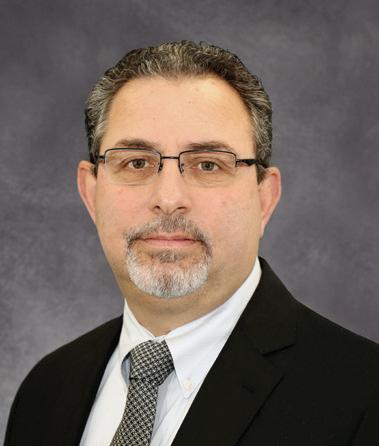
Our now 12-member county boards aren’t just a nod to our history; they’re a vital part of our democratic process. Each year, they meet to consider and nominate candidates for the Pioneer board of trustees and their respective county nominating boards, ensuring the membership has candidates to vote for in the upcoming election.
Beyond nominations, these county board members act as liaisons between the cooperative and the membership and sometimes use their county board experience as a stepping stone to run for a board of trustees position in the future. Through the years, the county boards have also served as sounding boards for board of trustees and cooperative management ideas, before these are shared with the entire membership. Their involvement helps keep the cooperative connected to the values and people it serves.
If you’ve ever considered stepping into a board leadership role, whether as a trustee or a member of our county boards, now is the time to place your name into consideration. You can do so on our website or by contacting us at member@pioneerec.com.

families
At Pioneer, our Commitment to Community goes far beyond providing reliable service — it’s about showing up, pitching in, and helping others. That same spirit of support and service is on full display each summer as Pioneer employees and their families give their time and talents at county fairs across Pioneer territory.
Whether mentoring youth in the show ring, volunteering behind the scenes, or continuing family traditions rooted in agriculture and 4-H, they are helping keep their rural roots alive and passing along the tradition to the next generation.
The Dunhams
For Pioneer lineman Kirby Dunham and his wife, Kamryn, it’s also a time to give back. With deep ties to 4-H, they’re among the many volunteers who help make the Champaign County Fair a meaningful experience for local youth.
Kamryn began participating in 4-H in 2006 as a Cloverbud, joining a local horse club with her sister. Over the years, she stayed active in the program — competing, serving in leadership roles, and eventually representing the county as a Horse Ambassador, a position she’s held for six years, and she chairs the Champaign County Horse Ambassador committee.
“4-H was a big part of my life growing up. It gave me confidence, leadership skills, and a lot of opportunities I wouldn’t have had otherwise,” Kamryn says. “Now, I try to create those same opportunities for today’s youth.”
Kirby began his own 4-H experience in 2009. While he didn’t show animals, he participated through non-livestock projects — including his “Safe Use of Guns” project, which advanced to the state fair. Now, as a parent, he enjoys seeing the experience from a new perspective.
“One of my favorite parts of the fair now is getting to watch our son take part — whether it’s the tractor pulls or showing pygmy goats,” Kirby says.
Their four-year old son, Arden, (who’s pictured on this month’s cover) is already joining in. Last year, he participated in the lead-line class, giving him an early introduction to the fair and 4-H environment.
Through their years of involvement, both Kirby and Kamryn have seen firsthand the impact that 4-H can have on young people — developing communication, responsibility, and leadership skills that last far beyond fair week.
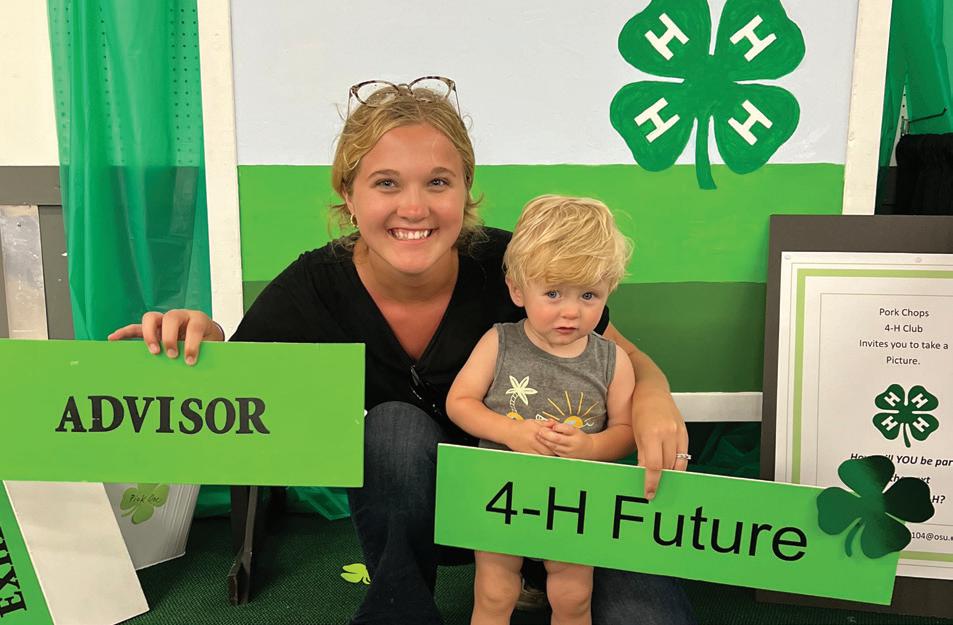
“4-H helped me come out of my shell when I was younger,” says Kamryn. “As an advisor now, I try to encourage kids who might not be the loudest voice in the room to step up, take chances, and grow.”
The Dunhams hope their children and others will see the value in being part of the program — not just in showing animals or earning ribbons, but in building skills and relationships that last a lifetime.
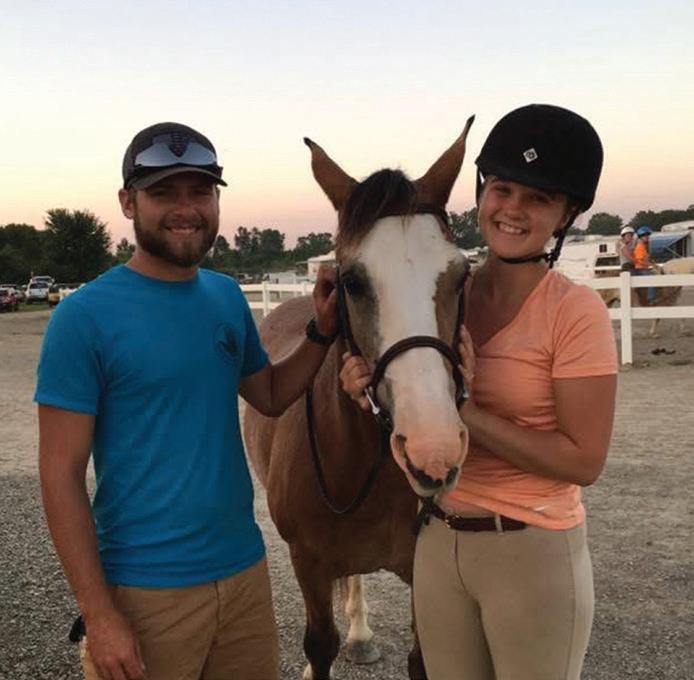
While they’re busy supporting youth programs throughout the week, the fair is also a place for tradition. For the past several years, Kirby and Kamryn have made a point to spend Sunday night at the fair together, watching the Queen contest and the pig and calf scrambles.
“It’s a fun way to wind down and take in everything the fair has to offer,” says Kamryn.
Since 1997, when their children first began showing lambs and entering cooking competitions through 4-H, Kris and Jim Johnson have been involved in the Miami County Fair and youth development programs.
“It was an easy choice for us when our children completed their time in 4-H and FFA, we knew we wanted to give back to the fair community,” says Kris, Pioneer’s human resources coordinator. “You see so much kindness surrounding your family during this one week in August, you can’t help but do something for others, too.”
And that’s what they’ve done, for more than 40 years. Today, Kris and Jim — both 4-H members in their youth — help lead the goat barn, assist with Junior Fair goat activities, and lend a hand in the sheep barn and anywhere else help is needed. Jim joined the Senior Fair Board, which he serves as vice president, and Kris volunteers wherever she can between goat and sheep shows. For 23 years, the couple also sold club lambs to 4-H and FFA youth and traveled to support kids as they showed animals across the U.S.
“When we started helping, it was because we loved the fair and what it, 4-H, and FFA stood for; we continued because our kids loved the fair, and we remain involved for the kids today who love the fair,” Jim says. “We’ve watched young people, including our own children, learn teamwork, responsibility, sportsmanship, and public speaking, and blossom into these remarkable adults. It’s incredibly rewarding.”
One highlight is seeing youth showmen competing against one another during the day and ending the evening playing cards together. It encapsulates what wonderful, down-to-earth kids are in these programs.

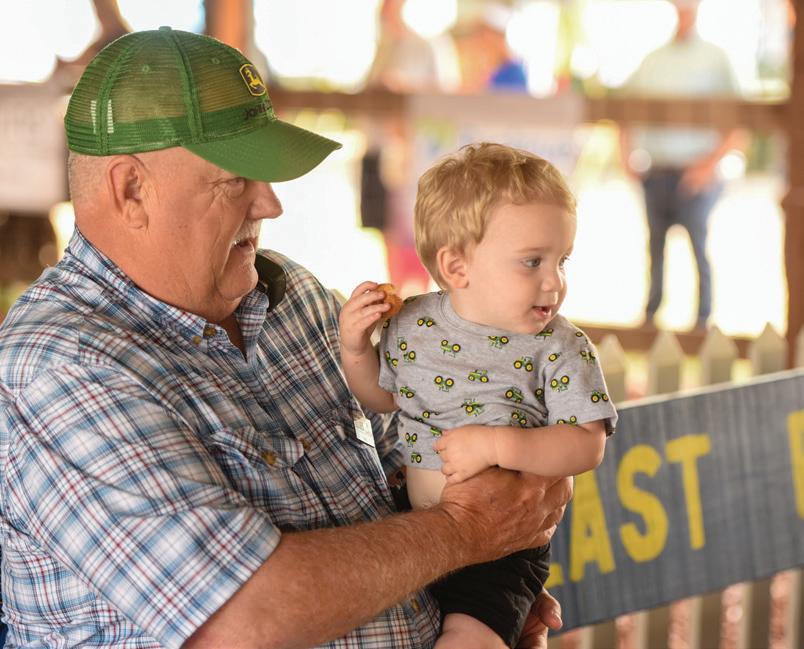
“Parents adopt children and children adopt parents during the week of the fair — everyone works together,” Kris says. “If a kid needs help, people are there to help them in a minute. That’s the type of community these programs and the Miami County Fair have fostered.”
The Johnsons acknowledge the countless volunteers and the Miami County Junior Fair Board leadership who made the fair possible for their own children and later their grandchildren, and continue to pay it forward. “We want to repay that appreciation by helping other families enjoy the same experience,” Jim says. “The fair wouldn’t be the same without all the people who put so much time into the event each year.”
Dustin Eckurd, a lineman at Pioneer, has been involved in the county fair for as long as he can remember. When he was six years old, he was showing pigs across Ohio. By the age of nine, he was competing at his local county fair, and his passion only grew from there.
“I raised and showed hogs until I was 14,” he says. “That’s when I caught my first calf in the county calf scramble, and from then on, I showed beef steers.”
Dustin’s wife, Jennifer, began showing dairy feeders at the age of nine and later added swine after catching one in the pig scramble.
“The county fair is where we met,” Dustin says. “It’s been an important part of our lives ever since.”
Now, that tradition is being passed to the next generation. Their son, Tucker, who is four — soon to be five — will participate in pee wee showmanship this year, as well as the open class barrow show.
“Seeing him take on his first fair project has been one of the biggest joys of my life,” Dustin says. “Raising animals teaches patience and responsibility — values we believe are important.”
This year, Dustin is taking his involvement even further. He was recently elected to serve as a Champaign County fair board member and is eager to give back. “I want to do whatever I can to make the fair as fun and meaningful as it was for me growing up,” Dustin says.
The fair has given the Eckurds so many memories — from their first shows to getting engaged — and now they get to share those same experiences with their children.
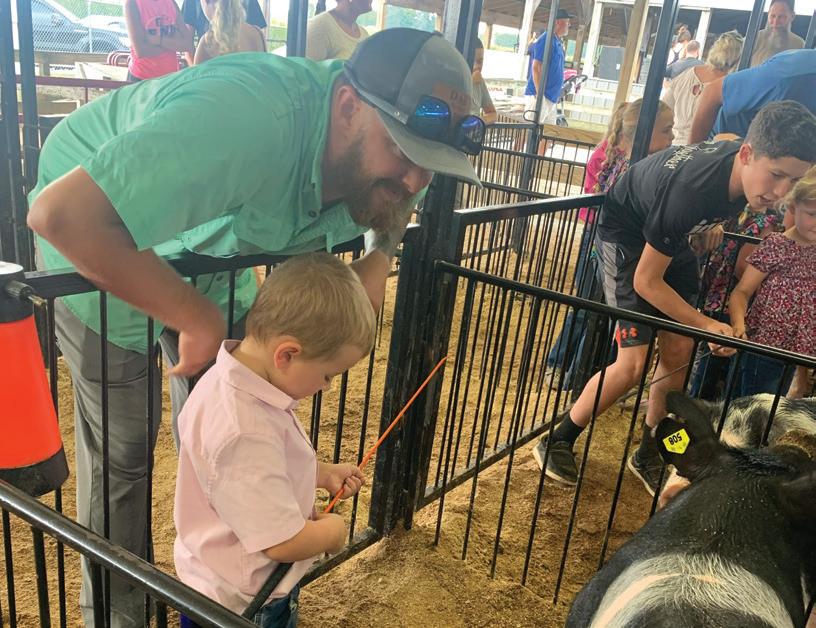





For the Wintrow family, attending the Miami County Fair is more than an annual tradition. With roots in agriculture and community service, the Wintrows have turned their passion into a multi-generational commitment to 4-H and local county fair participation.
Deanna, Pioneer’s district member services supervisor, previously served as an advisor for 20 years, and her husband, Chris, has been an advisor for more than 30 years. Deanna also helps coordinate the Miami County Pork Queen and Princess competition each year. Their involvement laid the groundwork for their son Clark’s path in the program, which started at a young age.
“I was going to club meetings before I was even old enough to join,” Clark recalls. “My show career started with pig jackpot shows, and I attended my first national show when I was in kindergarten.”
When the time came to officially join 4-H, Clark surprised everyone, including his parents, by choosing to show rabbits in addition to the family’s traditional focus — pigs. That decision led to a decade of growth, learning, and involvement in a wide variety of 4-H activities, from animal projects to leadership development. Clark also attended 4-H camp and eventually became a camp counselor. In 2024, Clark was awarded Outstanding 4-Her and Outstanding Swine Exhibitor for Miami County, all of which, Deanna says, helped him build confidence and leadership.
Participation in local, state, and national clinics and shows has pushed the Wintrows outside of their comfort zone and helped build a network of friendships with 4-Hers across the country.
Over the years, the Wintrow family’s 4-H experience has included raising and showing rabbits, market barrows, and breeding gilts. One of their favorite annual events is the Miami County Fair, where they continue the tradition of showing pigs and competing alongside friends, neighbors, and other local families. But their fair season involvement goes beyond just the show ring — the Wintrows also raise high-quality show pigs at home, helping connect local youth with animal projects for the fair season.
“Helping other families find their perfect show pig is one of the most rewarding parts of what we do,” Deanna shares. “It’s not just about the competition — it’s about teaching, supporting, building relationships, and seeing others succeed.”
Community service, helping others through 4-H, hands-on learning, and building memories have been their biggest motivations.
“It feels good to support the same community that’s always supported us,” Deanna says.
Their most treasured memories from the county fair are less formal — including camping at the fairgrounds with friends and family, sharing late-night games of UNO and cornhole, and laughing around the barn after a long show day.
“Whether it’s animals, art, science, cooking, or leadership — there’s something for everyone,” Deanna says. “It’s a place to discover who you are and what you’re capable of.”
Pioneer is pleased to announce the appointment of new members to the county nominating boards in Miami and Shelby counties, following recent changes to Pioneer’s Code of Regulations.
In March 2025, Pioneer members voted to approve the Code of Regulations change to allow county boards to fill vacated nominating board seats. Both the Miami and Shelby county boards have moved forward with appointments to unfilled seats.
In Shelby County, Dennis Grandey has been appointed to fill the seat that had remained vacant since 2023. Grandey will serve one year to complete the term and will be eligible for nomination for the 2026 election.
In Miami County, Grant Davis has been appointed to the seat vacated by Bob Zimmerman, who has resigned from the board due to relocating outside of Pioneer’s service territory. Zimmerman was re-elected in 2025, therefore Davis will serve the full three-year term.
With these appointments, all three counties now have a full 12-member nominating boards for the current term.
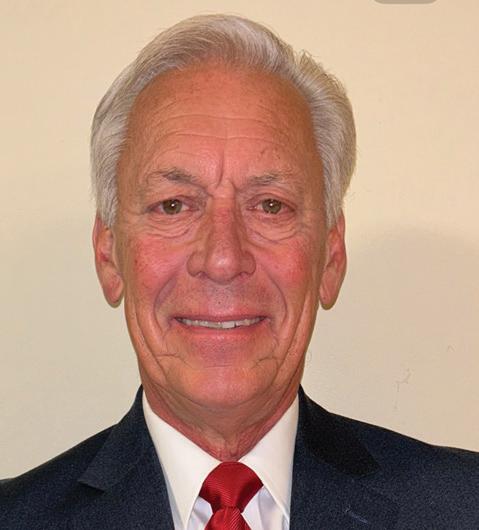

“Member engagement remains essential to the cooperative’s governance model — member participation helps ensure our board and leadership reflect the values and priorities of the communities we serve,” said Jodi Borger, Pioneer manager of communications and marketing. “We thank Dennis and Grant for their commitment to service and look forward to their contributions.”


OurSolar is a community solar program that offers one of the cleanest and most affordable renewable energy sources available. By grouping solar panels together, costs can be shared, power output can be maximized, and hassles of rooftop installation can be avoided. Pioneer currently has panels available! Contact us at member@pioneerec.com or 800-762-0997 for more information.

What is peak demand?
Peak demand is when electric use is higher than normal. Increased demand for electricity from the 24 electric cooperatives throughout the state of Ohio or even the 13-state PJM Interconnection region (the electric transmission territory that serves Ohio), can contribute to peak demand.
Why is peak demand important?
During peak demand, Pioneer Electric Cooperative’s power supplier, Buckeye Power, Inc., runs its large baseload power plants at full capacity. If the need arises, Buckeye Power can also fire up its supplemental gas-fired peaking plants or purchase power from additional sources, which all affect the wholesale power adjustment (WPA) portion of members’ electric rates.
Electricity cost is highest when it’s most needed — less than one percent of the hours in a year. The maximum or “peak” amount of electricity used helps to determine Pioneer’s future costs of power. When the peak goes up, so does the cost. By reducing, or deferring, the demand for electricity created by electric water heaters, home-heating systems, central air-conditioning systems, and other high-use appliances, such as washers and dryers, the cooperative helps reduce its costs for power.
In addition, environmental regulations have resulted in the retirement of numerous coal- and natural gas-fired power plants over the past decade. While renewable energy sources have replaced some of these plants, the generation capacity of these facilities is much lower than those that have been shut down. During extreme weather conditions, this can create an alarming burden on the electric grid —
so much so that in extreme cases, rolling blackouts could become necessary.
How does this affect load management participants?
Members who participate in Pioneer’s voluntary load management program help the cooperative lower the demand for electricity and reduce the risk of higher WPA costs and rolling blackouts. Rebates and incentives are also available to members who choose to participate in these programs.
Buckeye Power may issue a peak alert during these periods of high demand. These alerts are often implemented when extreme weather conditions and temperatures occur — the hottest days during the summer and the coldest days in the winter, both in Ohio and across the PJM region. During a peak alert, load management devices installed on electric water heaters and HVAC systems in participating members’ homes may be activated, temporarily disconnecting the appliance from the power supply.
Summer load management efforts typically take place on very hot and humid days between 1 and 7 p.m. Winter load management may occur on bitter cold days between 6 and 10 a.m. and/or from 4 to 8 p.m. Depending upon weather conditions and power loads, the time and duration of load management efforts may be adjusted.
If you have interest in being enrolled in Pioneer’s load management program, please visit pioneerec.com/memberprograms/peak-load-management or contact our office at 800-762-0997 or email energyadvisor@pioneerec.com
Any member who would like to be notified when peaks occur to help reduce use during these times, may also sign up for peak alert text notifications by texting PEAK to 800-762-0997.


General load management information:
• Appliances equipped with radio-control switches can include: geothermal units, heat pumps, central air conditioning, and water heaters.
• A load management device, like the gray box shown above, is typically installed near the water heater or HVAC system.
• A green light on the device is normal and indicates that electricity is flowing to the water heater or HVAC system.
• A red light indicates that load management is taking place and that the water heater is not receiving power and the HVAC system power is being cycled on and off.
• Air conditioners: Cycles the compressor of your HVAC unit for brief periods of time. Cycling periods are brief, so that program participants rarely experience a change in comfort. During these cycles, the air handler continues to run, circulating air throughout the home.
• Water heaters: The switch interrupts the power supply to the heating elements; however, since the water in an electric water heater stays warm for several hours without power, most members will never notice the temporary shutdown.
It’s that time of year again — a season of sunshine, barbecues , and backyard memories. If you’re trying to stay comfortable this summer but want to avoid blistering energy bills, give these easy, high-impact energy saving tips a try:
1. Install a programmable thermostat
According to the Department of Energy, you could save approximately 10% annually on cooling costs with the use of a programmable thermostat. Set your thermostat between 74°F and 78°F when you're home and increase it to 82°F to 85°F when you’re away to maintain a comfortable balance between energy efficiency and indoor comfort.
2. Close curtains or blinds during the day
Closing curtains or blinds, especially on south and west-facing windows, can reduce indoor heat gain by up to 33%.
3. Set ceiling fans to rotate counterclockwise
Adjusting your ceiling fan to spin counterclockwise in the summer creates a downdraft, making you feel cooler and allowing you to raise your thermostat setting by about 4 degrees without compromising comfort.
4. Open windows on breezy days
Opening windows on days when there’s a natural draft or breeze can create airflow through your home.
5. Run heat-producing appliances at night
Dishwashers, washing machines, and dryers generate heat. Use them in the evening to avoid adding heat and increased, or peak, demand during the day.
6. Use a clothesline
Utilizing a clothesline in place of a clothes dryer is an energy efficient way to dry your clothing.
7. Unplug unused devices
Unplugging unused devices can reduce standby power usage, which accounts for 5% to 10% of residential energy consumption.
Summer comfort doesn't have to come with a financial heat wave. By making a few smart, simple changes — from adjusting your thermostat to switching your lightbulbs — you can create a cooler home and a more affordable energy bill. Every degree, every bulb, and every unplugged device adds up.

Setting your water heater temperature above 120°F can be a waste of energy and money. Take charge of your energy costs by turning down the temperature. Then, contact your energy advisor at Pioneer Electric Cooperative for other money-saving tips and check out SmartHub’s enhanced use data, which itemizes your electric bill and shows you which appliances are costing you the most. Remember, when it comes to saving energy, you have the power!
Find out how small adjustments add up with SmartHub’s enhanced use data. Learn more about it at www.pioneerec.com/my-account/smarthub.



Orville J. Bensman
Ronald P. Clark
Harold T. Covault
Donald D. DeWeese
Duane L. Engel
Dwain E. Hollingsworth
Terrence A. Householder
Douglas A. Hurst
Edward P. Sanders
Paul R. Workman
Trustees Emeritus
Thomas J. Musick
BY JILL MOORHEAD
The world’s first superhero makes a return to his Cleveland-forged roots.

“Up, up, and away!” Before Superman became a global icon, he was a glimmer of hope imagined in a Glenville bedroom. Forged by two Jewish teens during the Great Depression and shaped by the steel-tough spirit of Cleveland, Superman is as much a product of this city as he is of Krypton...

In 1933, 11th graders Jerry Siegel and Joe Shuster began crafting a character who would become the first comic-book superhero. Their early version of Superman was a villain, but by 1938 — in the pages of Action Comics #1 from what is now DC Comics — he had evolved into the symbol of truth and justice known worldwide. Raised in Cleveland’s Glenville neighborhood, both boys were the children of Jewish immigrants, delivering groceries to help their families survive the Great Depression.
Superman was their way of imagining a better world.
“Superman is one of Cleveland’s greatest exports,” says Valentino Zullo, assistant professor of English at Ursuline College and co-director of the Rustbelt Humanities Lab. “We’re not exporting steel; we’re exporting culture. The superhero genre was created here.”
That culture is more than mythology — it’s history. Cleveland’s influence is built into Superman’s DNA: His job as a journalist echoes the student newspaper the creators worked on, the Glenville Torch; his resilience mirrors the city’s own fight through industrial decline. Even his nickname — the Man of Steel — was inspired by Cleveland’s booming steel industry.
The story of Superman is also the story of the American immigrant. “He’s from a dying planet,” Zullo says. “He gets a last chance, but it’s also his first chance. That mirrors the journey of so many immigrants trying to make a home in a new world.”
That resonance is being rediscovered today, especially in Cleveland, where Superman is experiencing a long-overdue homecoming. A new DC Studios movie, Superman, directed by James Gunn, was filmed in the city in 2024, with scenes shot at recognizable landmarks like the Arcade and the Cleveland Public Library. According to Bill Garvey, president of the Greater Cleveland Film Commission, the production brought more than $77 million in direct spending to northeast Ohio and created thousands of jobs.
“Clevelanders feel ownership of this story,” Garvey says. “This is where it all started. It was emotional to finally bring Superman home.”



• Siegel’s Boyhood Home: Drive down Kimberly Avenue between East 105th Street and Parkwood Drive to see the commemorative fence featuring Action Comics #1 panels.
• Superman Plaza (opening July 2025): At Ontario Street and St. Clair Avenue, outside the Huntington Convention Center.
• Cleveland Hopkins International Airport: Welcome display celebrating Superman’s Cleveland roots.
• Cleveland Public Library: Home to a vast collection of Superman memorabilia and site of ongoing Superman-related events.
• Cleveland History Center: Hosts rotating exhibits featuring the city’s role in pop culture history.
This summer, that homecoming becomes permanent. Thanks to the efforts of the Siegel and Shuster Society, led by Gary Kaplan — Jerry Siegel’s second cousin — Cleveland is unveiling a Superman plaza in the heart of downtown. Situated outside the Huntington Convention Center, the installation features a 19-foot stainless-steel Superman on a soaring pillar, plus bronze statues of Siegel, Shuster, Siegel’s wife, Joanne (the inspiration for Lois Lane), and a phone booth with Clark Kent’s clothes inside.
“He’s an intergenerational symbol of hope,” Kaplan says. “And we want the world to know he was born right here.”
The plaza is the culmination of years of effort by the society, which also restored Siegel’s boyhood home and installed commemorative fencing panels from Action Comics #1. At Cleveland Hopkins Airport, travelers are greeted with a display that reads, “Welcome to Cleveland, where the legend began.”
For comic-book artist and writer Sina Grace, that legend is very much alive. His recent graphic novel, Superman: The Harvests of Youth, was deeply inspired by Cleveland’s resilience. “I was so taken by the spirit of the city,” Grace says. “There are old factories turned into breweries, neighborhoods reinventing themselves. I wanted Smallville to have the same vibe — a big city that still feels like a small town.”
Grace will be in Cleveland this July for the movie release, taking part in events at the Cleveland Public Library, home to one of the largest Superman collections in the country, including memorabilia from the comics, TV shows, and films.
Chuck Colletta, a professor at Bowling Green State University who teaches superhero history, believes Superman endures because he became something more than a character: an American myth. “Even if someone’s never read a comic, they know Lois Lane. They know Kryptonite. Superman is part of our culture.”
And now, after more than 85 years, he’s part of Cleveland’s cityscape, too.




Ohio Cooperative Living is looking for photography submissions from electric cooperative members to be considered for use in our 2026 wall calendar. Appropriate subjects include landscapes, animal, floral, or wildcard (photos taken in Ohio will be given stronger consideration).
Winning submissions will receive a cash prize.
One photo entry per household.
High-resolution, color, digital images only.
Only JPEG or TIF file formats will be accepted.
Please send submissions by email attachment only to photo@ohioec.org
Photo format must be horizontal and capable of filling an 8x11-inch image area.
Provide an explanation of the photo — the where, what, and when — as well as who took the photo.
Include your name, address, phone number, and the name of your co-op.
Submission deadline AUGUST 16, 2025


Ashland Comfort Control (419) 281-0144 comfortcontrolohio.com
Bowling Green
United Home Comfort (419) 352-7092 unitedhomecomfort.com
Chillicothe
Accurate Htg & Clg (740) 775-5005 accurategeothermal.com
Coldwater
Ray’s Refrigeration (419) 678-8711 raysrefrigeration.com
Defiance Schlatters Plbg & Htg (419) 393-4690 schlattersgeothermal.com
Dresden Federal Htg & Clg (740) 754-4328 federalheating.com
Findlay Knueve & Sons Inc. (419) 420-7638 knueve.com
Gahanna
Custom A/C & Htg (614) 552-4822 customairco.com/ geothermal
Groveport Patriot Air (614) 577-1577 patriotair.com
Holgate Holgate Hardware (419) 264-3012
Kalida Knueve & Sons Inc. (419) 420-7638 knueve.com
Sarka Electric (419) 532-3492 sarkaelectric.com
Mansfield Eberts Energy Center (419) 589-2000 ebertsheatingandcooling. com
Marion Wenig’s Inc. (740) 383-5012 wenigsinc.com
Medina Sisler Heating (330) 722-7101 sislerwaterfurnace.com
Mt. Vernon Cosby Htg & Clg (740) 393-4328 cosbyhc.com
New Knoxville New Knoxville Supply (419) 753-2444 newknoxvillesupply.com
Portsmouth Accurate Htg & Clg (740) 353-4328 accurategeothermal.com
Sidney Lochard Inc. (937) 492-8811
Sunbury Westin Air (614) 794-1259 geothermalcentralohio.com
Toledo Overcashier & Horst (419) 841-3333 ohcomfort.com
Wellington Wellington Indoor Comfort (440) 647-3421



While classic Lyman watercraft still cruise Ohio’s waters, new ones are on the prowl for the first time since the last century.
AND PHOTOGRAPHS BY JAMES PROFFITT
The colors of the hull can vary — white, yellow, blue, turquoise — but just about anyone on Lake Erie knows the classic Lyman lines: a deep bow with lapstrake wood, a certain wave-busting flare, the captain’s easygoing air of pride.
The original Lyman Boat Works in Cleveland was founded in 1875, relocating in 1928 to Sandusky, where most of its fleet of more than 60,000 vessels was produced. The company stopped making wooden boats in 1973, though it continued with fiberglass until the early 1980s, when it capsized in bankruptcy.
After all that time, thousands of wooden Lymans still ply the waters — most of them on Lake Erie — and they have a fierce following.
Perhaps the fiercest is Tom Korokney, a.k.a. “Doc Lyman.” He purchased the tooling, jigs, fixtures, and archived records from then-defunct Lyman during bankruptcy and moved it all to Lexington in Richland County.
“I’ve used the tooling to duplicate parts through the years,” he says. “And the documentation — I’ve got all the original hull records.” Those records, Korokney says,




You don’t have to buy a vintage boat these days to get on the water in true Lyman style. Thanks to Tom Korokney’s saving everything he did from the Lyman factory and a Seville company’s COVID-fueled need to keep employees busy, new Lymans
are being built for the first time since the original company went under more than 40 years ago.
Adam Sublett operates Benchmark Craftsmen in Seville, which has designed, fabricated, and managed displays for trade shows, museums,
and other customers since its founding 50 years ago by Adam’s father, Nate. But when COVID struck, operations came to a standstill.
“I knew if these craftsmen were let go or laid off, I wouldn’t get them back,” Nate says of his employees. “So we




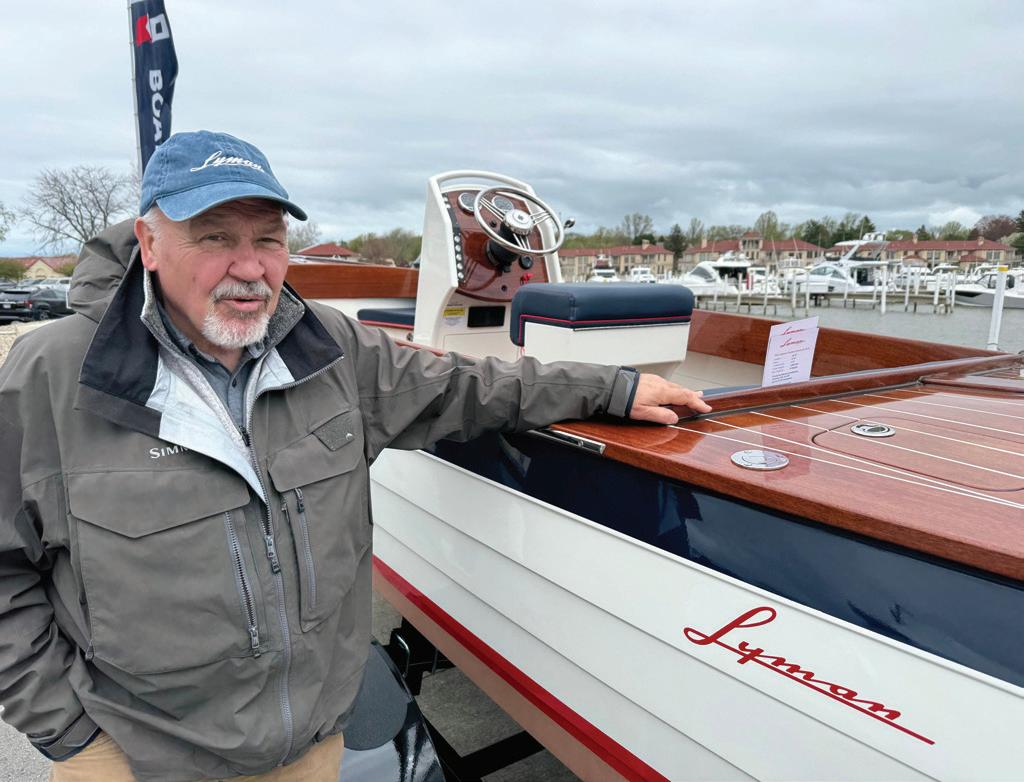
are sought after by folks who desire historical papers, including certificates of authenticity, for their boats.
And while he’s backed off restoration and repair work these days, Doc Lyman, 73, is still the boats’ No. 1 cheerleader. He spent four years writing Lyman Boats: Legend of the Lakes, published in 2004. He also hosts a Lyman podcast, founded the Lyman Boat Owners Association, and currently is working to establish a Lyman museum in Sandusky.
“There’s a lot of Lyman boats that have been in families for years,” he says. “Especially the smaller ones. They tend to survive because a lot of times they’re just weekend boats, so people take them home and they go in the garage. There’s a lot of second- and third-generation outboards that have been out there for years.”
That’s not lost on Kenny Kreutzfeld, of K&M Restorations in Marblehead, who says folks come to him with an old Lyman that may have been their parents’ or grandparents’ and they’d like to see it back on the water.

got busy.” Adam and Nate came up with the idea to relaunch Lyman, and Chippewa Boatworks was born.
They got in touch with Kurt Cerny, a marine architect and yacht designer in Annapolis, Maryland. Cerny grew up spending time between North
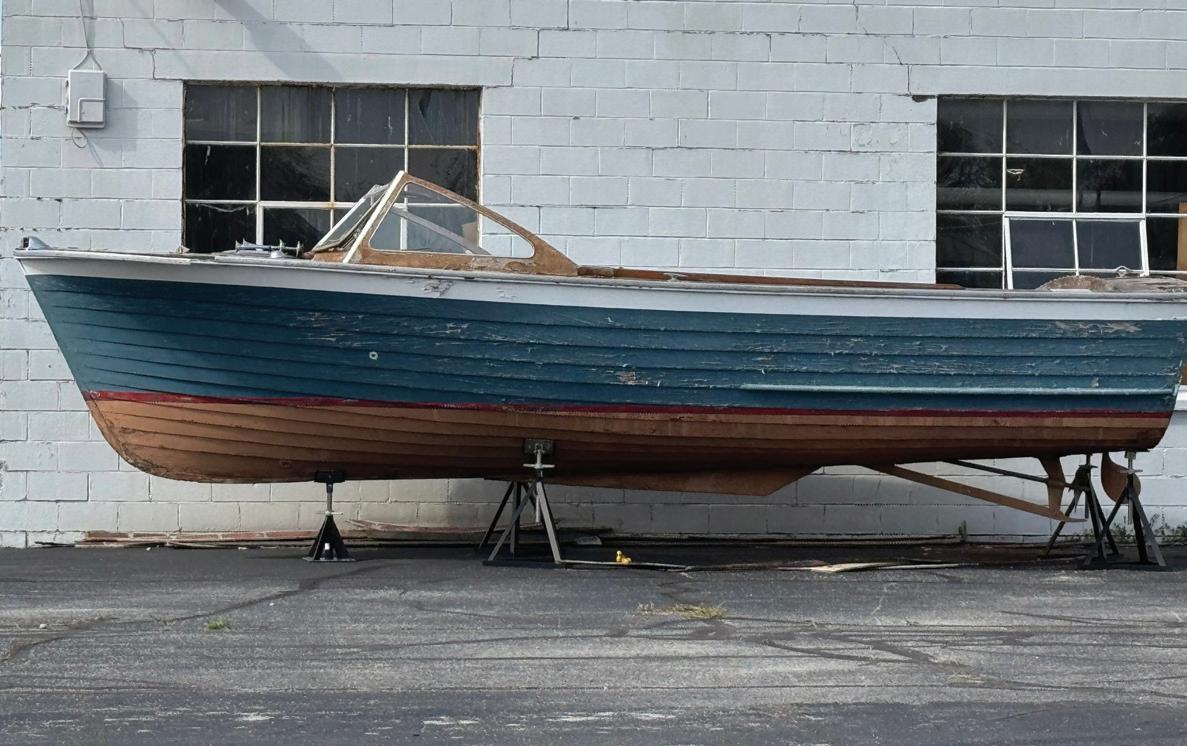
He points to one Lyman in his shop, surrounded by vintage equipment such as a band saw from the late 1800s, a Bridgeport drill press from 1938, and a power hammer dating from World War II: “This one here, it’s been in the family since it was new or almost new,” he explains. “That’s pretty common.”
Kreutzfeld says boats like the 26 -foot Lyman he’s currently working on (named The Five Pecks) are the most in demand.
“It’s definitely what everyone wants nowadays,” he says as he carefully glues together two pieces of white oak. “It’s a pretty good boat for just about everything. They do real well in Lake Erie, especially since they got the weight distribution just right, a deep-V hull up front — zips through the water just right. Fifteen to 20 miles per hour and you can cut through just about anything.”
“We’re trying to preserve the legacy with a museum here in the near future,” Korokney says. “And the most important thing: We’re going to continue to keep these classic works of art floating.”


Olmstead and Marblehead, where he remembers listening to his father and uncles debate the merits of their boats. He says all of those conversations inevitably ended with something along the lines of “But nothing handles these waters like that old Lyman we had.”

So they traveled as a group to make their pitch to Korokney.
“We went to see Tom and those crazy archives he hauled out of the Lyman factory,” Nate says. “We went through
Continued on page 30


drawing after drawing after drawing and picked one we wanted to pattern our work after. Curt went back to Annapolis and came up with a design, and we went for it.”
Nate says the process was not without challenges. While many of the Benchmark employees were boaters, none had actually built a boat before.
But they figured it out. Now, Chippewa produces three handmade models, all based on a 1957 Lyman Runabout, 16.5 feet in length. But these are definitely not your grandparents’ Lymans.
“They’re all-wood hulls, mahogany with lapstrake construction,” Nate says, standing in front of one of three new Lymans at the Catawba Island Boat Show recently. “But every piece of wood is fully epoxy-coated and soaked. All the finishes are modern, so there’s no sanding and varnishing

Chippewa Boatworks’ new Lymans don’t include classic dials and gauges. All things mechanical are seen on a digital screen or a cellphone.
to keep up with like you had to do with the old Lymans.”
Also, there are no dials or gauges at the helm — just a digital screen that communicates directly with the boat’s engines (which can also wirelessly send readings and other info to a phone or other device). “It’s as modern as it gets,” he says.
Nate says there are a handful of companies making new wooden boats these days — but there’s only one Lyman. “Old or new,” he says, “any Lyman on the water definitely gets attention.”





































Members scratch that creativity itch with the ancient art of paper quilling.

BY MARGARET BURANEN
Like many during COVID, Lillian Cooper and her mother, Clarissa, searched and searched for activities to do at home — all the better if they came upon an art form they hadn’t tried before.
Lillian already enjoyed doing origami (the Japanese art of paper-folding), so when she found the ancient art of quilling, also known as paper filigree, it seemed like something she could get into.
The Coopers, residents of Orient and members of Lancaster-based South Central Power Company, found a book about quilling at their local library, read online articles, and watched instructional videos on YouTube; that research solidified their interest, and they ordered the special paper and tools online.
Terri Riddle of Loveland, a painter who works mostly in oils and acrylics, got interested in quilling after her husband gave her a Cricut machine, which can cut paper in custom, specialized ways. Riddle had a project in mind, but realized she needed to learn quilling to finish the parts that the Cricut couldn’t handle — so she taught herself.
She finds quilling both satisfying and relaxing. “It’s a very beginner-friendly craft,” she says. “You can do it while watching TV, and the designs can be simple or more complex.”
Riddle, a member of the Deerfield Township Art Alliance, found she enjoys sharing quilling with other people, so she started teaching filigree classes in 2022. This year she’ll teach 30 or more classes at several locations.
Quilling has been practiced for centuries, perhaps even as far back as ancient Egypt, though it was particularly popular in Europe during the Renaissance. It takes its name from the tool its first practitioners used: a bird feather. To create a piece of quilling art, the artist threads one end of a strip of paper through a slit in the quill, the modern tool modeled after those feathers of old. Then, keeping even tension on the paper, the quill is spun or twirled so that the strip of paper coils tightly around it. One by one, each tiny coil is placed on edge and glued onto a piece of paper or within a frame.
Cooper says that the most challenging part is keeping the tension consistent on the paper coil. It’s not hard to learn, she says, “but you have to have some fine-motor skills.” She enjoys turning her quilling art into jewelry, such as pendants for necklaces or earrings.
Riddle, who has sold her paintings at art shows for years, now also sells her framed quilling work and greeting cards right alongside them.
These days Cooper, now 17 and a rising senior in high school, alternates quilling projects with other forms of art that she enjoys — crocheting, origami, amigurumi (crocheting stuffed animals), and wool felting among the favorites. She’s taken art classes at school and hopes to take more in college, and she’s already taught a class in quilling for adults, with her mom serving as her assistant.
Riddle says she meets many adults who say they aren’t creative, but people who take her classes are frequently surprised at what beautiful art they can make with quilling. “I always tell people,” she says, “you’re never too old or too young to learn.”
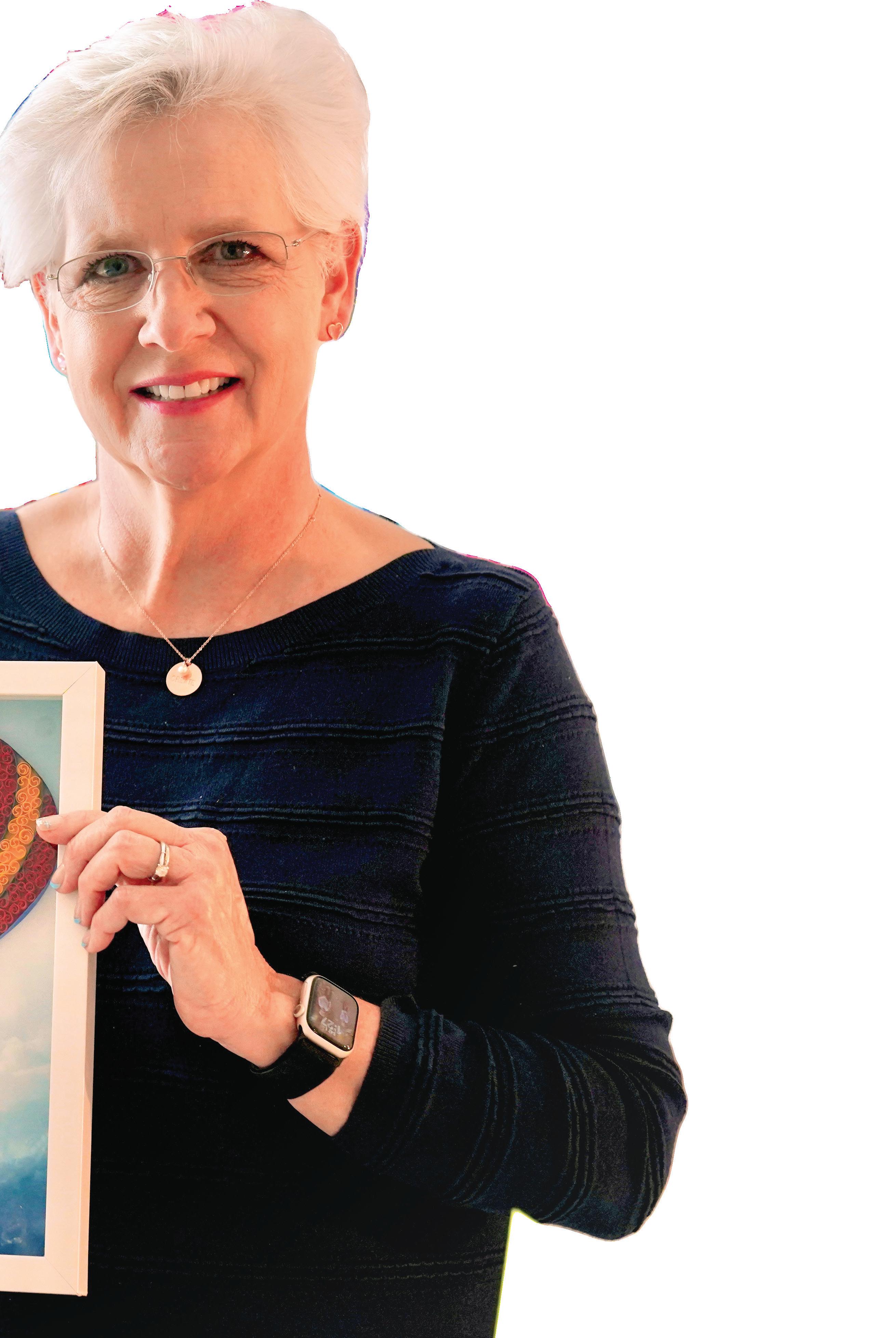
People don’t always do what their doctor says, but when seasoned veteran emergency room physician, Dr. Philip B. Howren, says every senior should have a medical alert device, you better listen up.
“Seniors are just one fall away from being put in a nursing home,” Dr. Howren said. “With a medical alert device, seniors are never alone. So it keeps them living independently in their own home. That’s why seniors and their family members are snapping up a sleek new medical alert device that comes with no monthly bills ever,” he said.
Many seniors refuse to wear old style help buttons because they make them look old. But even worse, those medical alert systems
come with monthly bills.
To solve these problems
Universal Physicians, a U.S. company went to work to develop a new, modern, state-of-the-art medical alert device. It’s called “FastHelp™” and it instantly connects you to free unlimited nationwide help everywhere cell service is available with no contracts, no deposits and no monthly bills ever.
“This slick new little device is designed to look like the pagers doctors wear every day. Seniors love them because it actually makes them look important, not old,” Dr. Howren said.
FastHelp is expected to hit store shelves later this year. But special newspaper promotional giveaways are slated for seniors in select areas. ■

■ NO MONTHLY BILLS: “My wife had an old style help button that came with hefty bills every month and she was embarrassed to wear it because it made her look old,” said Frank McDonald, Canton, Ohio. “Now, we both have FastHelp™, the sleek new medical alert device that our grandkids say makes us look ‘cool’ not old,” he said. With FastHelp, seniors never have to worry about being alone and the best part is there are no monthly bills ever.
It’s just what seniors have been waiting for; a sleek new medical alert device with no contracts, no deposits and no monthly bills that instantly connects you to free unlimited nationwide help with just the push of a button for a one-time $149 price tag that’s a real steal after today’s instant rebate
The phone lines are ringing off the hook.
That’s because for seniors born before 1961, it’s a deal too good to pass up.
Starting at precisely 8:30am this morning the Pre-Store Release begins for the sleek new medical alert device that comes with the exclusive FastHelp™ One-Touch E 911 Button that instantly connects you to unlimited nationwide help everywhere cell service is available with no contracts, no deposits and no monthly bills ever.
“It’s not like old style monitored help buttons that make you talk to a call center and only work when you’re at home and come with hefty bills every month. FastHelp comes with state-of-the-art cellular embedded technology. That means it works at home or anywhere, anytime cell service is available whether you’re out water-
(Continued on next page)

get FastHelp, the sleek new medical alert device because it instantly connects you to unlimited nationwide help everywhere cell service is available with no contracts, no deposits and no monthly bills ever.
ing the garden, driving in a car, at church or even hundreds of miles away on a tour or at a casino. You are never alone. With just a single push of the One-Touch E Button you instantly get connected to free unlimited help nationwide with no monthly bills ever,” said Jack Lawrence, Executive Director of Product Development for U.S. based Universal Physicians.
“We’ve never seen anything like it. Consumers absolutely love the sleek new modern design and most of all, the instant rebate that practically pays for it and no monthly bills ever,” Lawrence said.
FastHelp is the sleek new medical alert device with the best of combinations: a quality, high-tech engineered device that’s also an extremely great value because there are no monthly bills ever.
Better still, it comes with no contracts, no deposits and no monthly bills ever – which makes FastHelp a great choice for seniors, students and professionals because it connects to one of the largest nationwide networks everywhere cell service is available for free.
And here’s the best part. All those who already have an old style monitored medical alert button can immediately eliminate those monthly bills, which is why Universal Physicians is widely advertising this announcement nationwide.
“So if you’ve ever felt a medical alert device was too complicated or expensive, you’ll want to get FastHelp, the sleek new medical alert device with no monthly bills,” said Lawrence.
The medical alert device slugfest was dominated by two main combatants who both offer old style monitored help buttons that come with a hefty bill every month. But now Universal Physicians, the U.S. based heavyweight, just delivered a knockout blow sending the top rated contenders to the mat with the unveiling of FastHelp. It’s the sleek new cellular embedded medical alert device that cuts out the middleman by instantly connecting you
directly to highly trained 911 operators all across the U.S. There’s absolutely nothing to hook-up or install. You don’t need a land line and you don’t need a cell phone. Everything is done for you.
“FastHelp is a state of the art medical alert device designed to make you look important, not old. Old style monitored help buttons you wear around your
neck, or require expensive base station equipment or a landline are the equivalent of a horse and buggy,” Lawrence says. “It’s just outdated.”
Millions of seniors fall every year and spend hours lying on the floor helpless and all alone with no help.
But seniors who fall and get immediate help are much more likely to avoid getting sent to a nursing

home and get to STAY living in their own home independently.
Yet millions of seniors are still risking their safety by not having a medical alert device. That’s because seniors just can’t afford to pay the monthly bills that come with old style medical alert devices.
That’s why seniors born before 1961 are rushing to cash in the whopping $150
instant rebate before the 21 day deadline ends.
So there’s no need to wait for FastHelp to hit store shelves later this year because seniors born before 1961 can get it now just by using the $150 instant rebate coupon printed in today’s newspaper before the 21 day deadline ends. If lines are busy keep trying, all calls will be answered. ■
1961: Use the rebate coupon below and call this Toll-Free Hotline: 1-800-330-4294 DEPT.
IF BORN AFTER 1961: You cannot use the rebate coupon below and must pay $299 Call: 1-800-330-9423 DEPT. HELP8677
THE BOTTOM LINE: You don’t need to shop around. We’ve done all the leg work, this deal is too good to pass up. FastHelp with the instant rebate is a real steal at just $149 and shipping and there are no monthly bills ever.
PROS: It’s the sleek new medical alert device that comes with the exclusive FastHelp One-Touch E 911 Button that instantly connects you to free unlimited nationwide help everywhere cell service is available with no contracts or deposits. It connects you to the vast available network of cellular towers for free and saves seniors a ton of money because there are no monthly bills ever making this deal irresistible. Plus it’s the only medical alert device that makes seniors look important, not old.
CONS: Consumers can’t get FastHelp in stores until later this year. That’s why it’s so important for seniors born before 1961 to call the National Rebate Center Hotline within the next 21 days. For those who miss that deadline, the sleek little medical alert device will set you back over $300 bucks.





















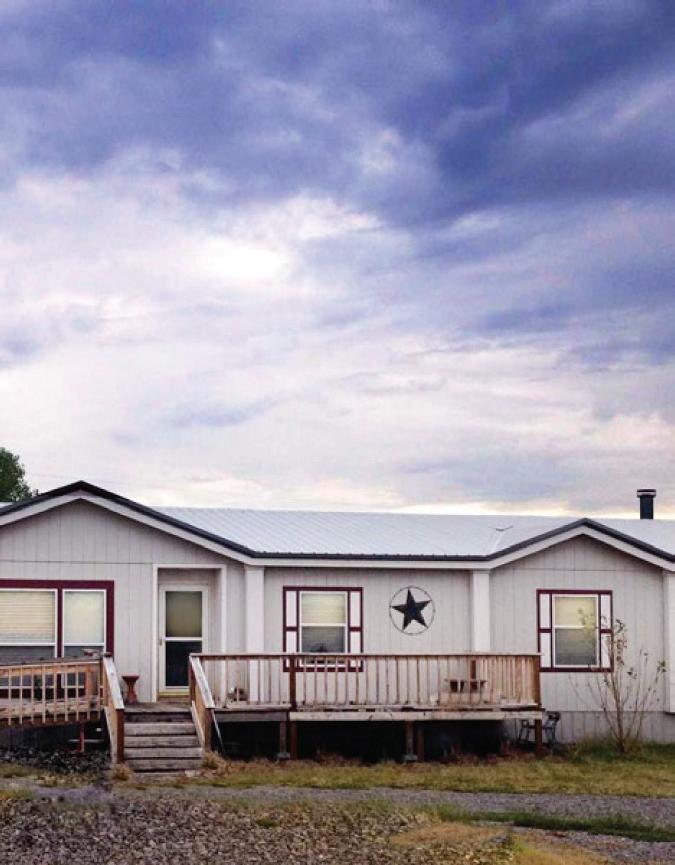







THROUGH OCT. 3 – First Friday Car Show, 122 N. Court St., Circleville, 5–9 p.m. Enjoy a night of classic cars, community fun, and a vibrant uptown atmosphere. All cars welcome! www.pickaway.com.
THROUGH OCT. 25 – Coshocton Farmers Market, Skip’s Landing, 22375 Co. Rd. 1A, Coshocton, Sat. 8:30 a.m.–noon. Locally grown produce, baked goods, and artisan crafts. Rain or shine. www. facebook.com/coshoctonfarmersmarket or email market.manager@coshfarmmarket.org.
JUL. 10–AUG. 28 – Exhibitions at the MAC, Peggy R. McConnell Arts Center, 777 Evening St., Worthington. Free. Two exhibitions will be on display: My Voice and Dance by Said OladejoLawal and In Good Company by Linda Hutchinson. The public is invited to an opening reception for the artists on July 10 at 6 p.m.; and to a guided gallery tour by Oladejo-Lawal on Aug. 7, 7–8 p.m., and by Hutchinson on Aug. 21, 7–8 p.m. www. mcconnellarts.org.
JUL. 13–AUG. 24 – CAPA Summer Movie Series, Ohio Theatre, 55 E. State St., Columbus, Wed.–Sun. 7:30 p.m., Sun. matinee 2 p.m. Series showcasing classic films and cult movies. “Cartoon Capers” Sat. 10 a.m. 614-469-0939 or www.capa.com.
JUL. 17–20 – Miami Valley Steam Threshers Association Annual Reunion, Pastime Park, Plain City. Our featured tractor will be Massey Harris–Massey Ferguson. Come and learn how farming was done many years ago. Enjoy scenic tractor rides, a Grand Parade on Friday, and truck/tractor pulls on Saturday. For more information, visit www. mvsteamshow.com.
JUL. 19 – Boogie on the Blacktop: Radio City, 135 E. Main St., Circleville, 6–11 p.m. Enjoy an electrifying
mix of rock, pop, and crowd favorites as the band takes the stage for a high-energy performance under the summer sky! www.pickaway.com.
JUL. 19 – Christmas in July Craft and Vendor Show, Fairfield Co. Fgds., 157 E. Fair Ave., Lancaster, 9 a.m.–3 p.m. Over 130 vendors, lunch items, Santa, kids’ crafts, face painting, and more! Sponsored by Fairfield County 4-H Advisory Board. Proceeds benefit county trips and scholarships. For vendor/crafter information, email Cindy at cag8845@gmail.com.
JUL. 19 – Uptown Classic 3-on-3 Basketball Tournament, 122 N. Court St., Circleville. Teams of three will compete in an exciting streetball showdown in the heart of the town. Register at www.teamsideline.com/sites/uptowncircleville/ home. More information available at www.facebook. com/UptownCircleville/events.
JUL. 24 – Thursday Trail Tour: Pickaway Trail, 23742–23700 Canal Rd., Circleville, 9:30–11:30 a.m. Free. Please dress to be outside and for a walk along various trail surfaces. An adult must accompany all children under 12. Program will be canceled in the case of inclement weather. For questions, email mellis@pickawaycountyohio.gov.
JUL. 24–26 – Goodtime Quilters Quilt Show, Ohio Christian University, Maxwell Center, 1476 Lancaster Pike, Circleville, 9 a.m.–4 p.m. Cash-only admission: $8 per day, $12 for 3-day pass. 150+ quilt display, raffle items, vendors, food, door prizes, demos, knife/scissor/garden tool sharpening. 740-332-6344 (Barb Harwood) or www.goodtimequilters.org.
JUL. 24–26 – 7 Mile Bluegrass Festival, 415 Lancaster Pike, Circleville. Enjoy a weekend of bluegrass music and provide needed support to our veterans! Admission is 7 non-perishable food items (never cash!) each day you attend; food collected is then donated to local veterans groups. Vernon McIntyre’s Appalachian Grass performs July 24, 6–7 p.m. 740-701-0834, billytex74@outlook.com, or https://festival2025.com/the-7-mile-bluegrassfestival-2025-lineup.
JUL. 25–26 – Canal Winchester Blues and Ribfest, downtown Canal Winchester, Fri. 5–11 p.m., Sat. noon–11 p.m. Free admission. Summer street celebration featuring live blues music, world-class ribs, a variety of quality non-rib food options, and a beer garden for ages 21 and over.
JUL. 12, 26 – Myths of the Mountains, Fort New Salem, 81 Settlers Lane, Salem. $8; 10 and under free with paying adult. Lamplight guided tour (about 1 hour) led by period-dressed guides, with each cabin housing a storyteller who spins tales of Appalachia. Gates open at 8 p.m.; groups begin tours every 10 minutes. 304-695-2220 or www. fortnewsalemfoundation.org.
AUG. 8–10 – Dulcimer Festival, Fort New Salem, 81 Settlers Lane, Salem, Fri. 5–9:30 p.m., Sat. 9 a.m.–9:30 p.m., Sun. 9:30 a.m.–3 p.m. Concerts, Appalachian artisans, and handson music workshops. 304-695-2220 or www. fortnewsalemfoundation.org.
614-270-5053, info@destinationcw.org, or www. bluesandribfest.com.
JUL. 26 – Black Wing Summer Blast Car Show, 3722 Marysville Rd., Delaware, 10 a.m.–1 p.m. Proceeds benefit Ohio Clay Target League – 6th to 12th grade youth shooters. Family-friendly, fun-filled day, 10 a.m.–5 p.m., also includes raffle, manufacturer rep expo, food trucks on-site, and more! 740-780-5287 or https://blackwingsc.com/ summer-blast.
JUL. 26 – Down on the Farm, Mount Oval Historic House and Farm, 3601 Emerson Rd. (off U.S. 23 S.), Circleville, 10 a.m.–4 p.m. Free admission. Antique tractors, animals, farmers market, demos, dulcimer music, Amish wares and food, ice cream, and much more. House tours $5. Call PCHS at 740-474-1495 or see the Mount Oval Historic House Facebook page.
AUG. 1 – First Friday Art Walk, downtown Zanesville, 5–8 p.m. Come downtown on the first Friday of each month, when all our participating galleries, studios, and small businesses are open at the same time! See our website for a map of current participants: https://artcoz.org/arts-district-map.
AUG. 1–3 – Annual Farm Days, Morrow Co. Fgds., 195 S. Main St. (U.S. 42), Mount Gilead. $5; under 12 free. Featuring Oliver and Cockshutt tractors and equipment. Sponsored by Morrow County Antique Tractor and Equipment Assoc. 740-885-4038 (Dwight Murphy) or www.morrowcountytractor.com.
AUG. 2 – Intro to Fishing, Canal Park, 23352 Canal Rd., Circleville, 8 a.m. Beginner-friendly program in which you will learn the basics of fishing, including how to cast, bait a hook, and identify common fish species. Fishing poles and bait will be available, but feel free to bring your own! Open to ages 5 to 15; children under 12 must be accompanied by adult. For questions or to register, please email mellis@ pickwaycountyohio.gov.
AUG. 7 – Thursday Trail Tour: Park Headquarters (West Loop), 16405 U.S. Highway 23, South Bloomfield, 9:30.–11:30 a.m. Free. Program will be canceled in the case of inclement weather. Please dress to be outside and for a walk along various trail surfaces. An adult must accompany all children under 12. For questions, email mellis@ pickwaycountyohio.gov.
THROUGH AUG. 7 – Fort Steuben Summer Concert Series, Fort Steuben Park, 120 S. 3rd St., Steubenville, Thur. 7–9 p.m. Free. Featuring a variety of live musical performances. 740-283-1787 or www. oldfortsteuben.com.
THROUGH AUG. 31 – Steubenville Catfish Crawl, downtown Steubenville. A dozen 8-footlong, intricately painted catfish will be on display around the downtown; grab a map and find them all! Maps available at Leonardo’s Coffeehouse, 159 N. 4th St., Steubenville, or online at www. steubenvillenutcrackervillage.com/catfish.html.
JUL. 12–13 – Ashland County Yesteryear Machinery Club Annual Show, Ashland Co. Fgd., 2042 Claremont Ave., Ashland. Featuring Buckeye Regional Cockshutt Club. Also toy show, Ashland Model Railroad Club, food vendors, flea market. Car show and kiddies’ pedal pull on Sunday. 330-4653387 (Kevin Williard), rwilliard1966@yahoo.com, www. yesteryearmachinery.org.
JUL. 15–19 – Ashland Chautauqua 2025: Breaking Barriers, Ashland. Living history performances and daytime workshops on Lucille Ball, Wernher Von Braun, Annie Sullivan, Steve Jobs, and more. Evening performances held at the Myers Memorial Band Shell at Brookside Park, Ashland. info@ashlandchautauqua. org, www.ashlandchautauqua.org.
JUL. 19 – The Redbuds: An Evening of Acoustic Folk Music, Buffalo Creek Retreat, 8708 Hubbard
THROUGH AUG. 25 – Rib City BBQ & Bluegrass, 746 NW Washington Blvd., Hamilton, Mon. 7–9 p.m. Free admission. Enjoy an evening of lively bluegrass music by Vernon McIntyre’s Appalachian Grass. Call 513-829-7427 before traveling.
THROUGH AUG. 27 – Bluegrass Wednesdays, Vinoklet Winery, 11069 Colerain Ave., Cincinnati, Wed. 6:30–8:30 p.m. Dinner, wine, and an evening of free entertainment by Vernon McIntyre’s Appalachian Grass. Reservations recommended. 513-385-9309, vinokletwinery@fuse.net, or www.vinokletwines.com.
Valley Rd., Seville, 7 p.m. Free. All-female folk group from Columbus will sing and play Appalachian folk songs on fiddle, guitar, banjo, and upright bass. 419853-6016 or www.ormaco.org.
JUL. 25 – Back Porch Swing Band, John Streeter Garden Amphitheater, 2122 Williams Rd., Wooster, 6:30 p.m. Free. The band plays a variety of good “old-timey” music, from Americana standards and early country to foot-tapping swing and early rock and roll. In the event of rain, concert will be held inside the Secrest Welcome and Education Center. 419-853-6016 6016 or www.ormaco.org.
JUL. 25–26 – SAR Meeting and Ceremony, Fort Laurens, 11067 Fort Laurens Rd. NW, Bolivar, 10 a.m.–4 p.m. In addition to the annual meeting, the Sons of the American Revolution will perform a traditional D.C.-style Changing of the Guard ceremony in front of the Tomb of the Unknown Soldier. 330-874-2059 or www.fortlaurens.org.
JUL. 26–27 – Zoar Antiques Show, Historic Zoar Village, 198 Main St., Zoar, 10 a.m.–4 p.m. $12; 12 and under free. Shop from high-quality artisans and antique dealers, enjoy a juried craft and art show, and tour historic buildings. Variety of dealers, artisans, and folk artists throughout the village. 330-874-3011 or www.historiczoarvillage.com.
JUL. 27 – Millersburg Food Run 10K/5K and 1-Mile Race, Hipp Station, 62 N. Grant St., Millersburg, 8 a.m. Registration opens at 7 a.m. Cost: $8-$45 Funds raised go to the Love Center Food Pantry. https://runsignup.com/Race/OH/Millersburg/ MillersburgFoodRun.
JUL. 28–AUG. 3 – Columbiana County Fair, 225 Lee Ave., Libson. 330-424-5531 or www. columbianacountyfair.com.
JUL. 28–AUG. 3 – Medina County Fair, 720 W. Smith Rd., Medina. 330-723-9633 or www.medinaohiofair. com.
JUL. 31–AUG. 2 – Northern Ohio Chevelle Show, Best Western Plus, 15471 Royalton Rd., Strongsville. Chevelles, Malibus, El Caminos, Sprints,
JUL 19 – Vernon McIntyre’s Appalachian Grass, Garber Nature Center, 9691 OH-503 N., Lewisburg, 7–9 p.m. Join us for a fun evening of special mountain music. 937-962-5561, pcpdevents@gmail.com, or www.preblecountyparks.org.
JUL. 20–26 – Butler County Fair, Butler Co. Fgds., 1715 Fairgrove Ave., Hamilton. Family-style fun, with down-home food, handmade crafts, farm animals, tractor pulls, rodeos, plus bluegrass music! Vernon McIntyre’s Appalachian Grass will perform July 20, 7:30–9 p.m. www.butlercountyohfair.org.
JUL. 25–27 – Annie Oakley Festival, Darke Co. Fgds., Gate 5, Greenville, Fri./Sat. 9 a.m.–9 p.m., Sun. 9 a.m.–5 p.m. Family-friendly festival honoring Darke County’s most famous daughter, with western arts, cowboy mounted shooting, shooting contests, musical performances, and much more. www. annieoakleyfestival.org.
JUL. 26–27 – Gathering at Garst, 205 N. Broadway, Greenville, Sat. 10 a.m.–8 p.m., Sun. 11 a.m.–5 p.m. Free. Live historical reenactments, booming cannons, and engaging encampments, plus modern fun with artisan vendors, food vendors, local brews, and live music. www.darkecountyparks.org/gathering2025.
Beaumonts, and Lagunas. DJ, games, door prizes, raffle, 50/50, and entertainment. Proceeds will benefit the Marines Toys for Tots program. www. northernohiochevelleclub.com.
AUG. 1 – First Fridays on Fourth, 155 N. 4th St., Steubenville, 6–10 p.m. Free. Nineties-themed celebration features crafts, games, food trucks, live music, and activities to stimulate the imagination. www.theharmoniumproject.org/first-Fridays.
AUG. 1–3 – Silver Kings of Yesteryear Festival, Mary Fate Park, 200 Sandusky St., Plymouth. Featuring Silver King and Plymouth tractors. All brands of antique tractors and farm-related equipment welcome. Swap meet for Silver King parts all weekend. Vendors, entertainment, raffle items, and 50/50 567-275-1105 or silverkingtractors@gmail.com.
AUG. 2 – Jazz under the Stars: Chris Hovan’s Organic Trio, Uptown Park, Medina, 7 p.m. Free. Tapping into the current Hammond organ revival, the group revisits the classic organ combo genre, covering modern jazz repertoire and jazz standards. Bring your lawn chairs, blankets, and picnics. In the event of rain, concert will be held at St. Paul’s Episcopal Church, 317 E. Liberty St., Medina. 419-8536016 or www.ormaco.org.
AUG. 2 – Zoar Free Speaker Series: “The Ohio Tea Company,” Historic Zoar Village, 198 Main St., Zoar, 11 a.m.–1 p.m. The speaker will discuss the history of tea and tea customs. Open to the public with free parking near the School House. 330-874-3011 or www. historiczoarvillage.com.
AUG. 10 – Cliff Habian Trio, Wadsworth Public Library, 132 Broad St., Wadsworth, 2–3 p.m. Free. Three of northeast Ohio’s finest jazz musicians: Cliff Habian on piano, Jeff Slater on upright bass, and Eric Everett on drums. Seating will be on a first-come, first-served basis. 419-853-6016 or www.ormaco.org.
AUG. 11–17 – Jefferson County Fair, 1505 Friendship Park Rd., Smithfield. 154th annual celebration of agricultural achievements and fun for all. https:// thejeffersoncountyfair.com.
AUG. 2 – Biergarten Band Night, Liberty Home German Society, 2361 Hamilton Cleves Rd., Hamilton. Doors open at 5 p.m. Food, music, and German beer. German band Vereins Musikanten plays 6–10 p.m. 513-571-6198, https://libertyhome.net, or Liberty Home Association Facebook page.
AUG. 2 – Vernon Fest, Famous Old Time Music Co., 1196 Ross Millville Rd., Hamilton, noon–11 p.m. $10–$15. Featuring Vernon McIntyre’s Appalachian Grass plus other fine regional bands. Guest appearance by jazz guitarist Michael Wingfield. Raffles, “split the pot,” and door prizes! Food and drink for sale on-site. Bring a lawn chair. 419-568-1220, vernon@iglou.com, or www.fotmc.com/vernon-fest.
AUG. 7–10 – World’s Longest Yard Sale, locations along U.S. 127 through Greenville. www.127yardsale.com.
AUG. 8–14 – Miami County Fair, Miami Co. Fgds., 650 N. County Rd. 25A, Troy. Competitions, entertainment, harness racing, tractor pulls, art exhibits, games and rides, and much more. 937-3357492 or www.miamicountyohiofair.com.
THROUGH AUG. 1 – Limaland Motorsports Park Races, 1500 Dutch Hollow Rd., Lima, 7:30–10:30 p.m. Pit races include Sprints, UMP Modifieds, Thunderstocks, and more! Pit gates open at 4:30 p.m., grandstand gates 5 p.m., warmup laps 6:30 p.m. Schedule subject to change. Check www. limaland.com for the most current information.
THROUGH OCT. 11 – The Great Sidney Farmer’s Market, 109 S. Ohio Ave., every Sat. 8 a.m.–noon. Vendors from all around the area provide great food, crafts, and more. 937-658-6945 or www.facebook. com/sidneyfarmersmarketoh.
THROUGH SEP. 14 – NWORRP Museum Summer Hours, Northwest Ohio Railroad Preservation Inc., 12505 Co. Rd. 99, Findlay, Sat./Sun. 1–4 p.m. $3; 12 and under, $2. Quarter-scale train rides, model train displays, museum tours, games, play area, and more. 419-423-2995, www.nworrp.org, or www. facebook.com/nworrp.
JUL. 2, AUG. 6 – Down on the Farm Story Time, Proving Ground Farm, 5670 E. Twp. Rd. 138, Tiffin, 10 a.m. Stories and activities geared for preschool-age children that focus on farming and nature. Families welcome! 419-447-7073, www. conservesenecacounty.com, or Seneca Conservation District on Facebook.
THROUGH AUG. 31 – Tecumseh!, Sugarloaf Mountain Amphitheatre, 5968 Marietta Rd., Chillicothe. $20–$75. Sit beneath the stars as sheer spectacle surrounds you with a herd of galloping horses, live military cannon in action, and dazzling battle sequences. www.tecumsehdrama.com.www. tecumsehdrama.com.
THROUGH NOV. 27 – Athens Farmers Market, Athens Community Center, 701 E. State St., Athens, Wed. 9 a.m.–noon. Open year-round Sat. 9 a.m.–noon. 740-593-6763, www.athensfarmersmarket.org, or www.facebook.com/afm.ohio.
JUL. 13 – Malinta Days Festival, Monroe Twp. Fire House, 8931 Co. Rd. K-2, Malinta, 10 a.m.–4 p.m. Free admission/parking. Flea market, music by EZ Pickens, chicken BBQ and other food, bounce houses, wagon rides, tour of historical caboose, train station, barn and auction. All kids’ activities are free. 419-966-9909 or www.facebook.com/Malintafest.
JUL. 18–19 – Family Fun Weekend: “Mid-Summer Celebration,” Northwest Ohio Railroad Preservation Inc., 12505 Co. Rd. 99, Findlay, 1–4 p.m. $5. Games, quarter-scale train rides, bounce house, and other family-friendly activities and events. 419-423-2995, www.nworrp.org, or www.facebook.com/nworrp.
JUL. 19 – Eats on the Street, downtown Kenton, 5–10 p.m. Free to attend. Food trucks, live music featuring multiple bands, draft beer, kids’ fun zone, car and bike show. 419-673-4131 or www.facebook. com/KentonHistoricCourthouseDistrict.
JUL. 25 – Fourth Thursday Food Truck Rally and S’More Walk, downtown Lakeview, 5–8 p.m., rain or shine. Food, fun, shopping, entertainment, and more. www.facebook.com/downtownlakeviewohio.
JUL. 25–27 – Hamler Summer Fest, Community Park, 100 S. First St., Hamler. $5–$7; under 16 admitted free with parent. Polka bands, German food, and fun. Parade on Saturday will celebrate Hamler’s 150th anniversary. Kids Day on Sunday. 419-966-3187 or www.hamlersf.com.
JUL. 26 – Flair on the Square, 1 Courthouse Square, Bryan, 10 a.m.–8 p.m. Free. Juried art fair, emerging artists exhibit, food trucks, live music, hands-on art projects, performing arts, and more. See the complete schedule at www.flaironthesquare.com.
JUL. 26 – Vernon McIntyre’s Appalachian Grass, Ottawa Metro Park, 2632 Ada Rd., Lima, 7 p.m. Free. Enjoy an evening of lively bluegrass music featuring lightning-fast instrumentals, close harmonies, and entertaining novelty songs. Stadium-style seating in the amphitheater or bring a lawn chair. 419-221-1232 or 419-223-1025,
JUL. 18 – ABBAFAB: The Premier ABBA Experience, Majestic Theatre, 45 E. Second St., Chillicothe, 7:30 p.m. $39–$59. www.majesticchillicothe.net.
JUL. 20 – Echoes of the Sea, Sugarloaf Mountain Amphitheatre, 5968 Marietta Rd., Chillicothe, 8 p.m. $16 50–$21 50; under 12, $14. A new musical production that tells the story of a daring young man joining a pirate crew in hopes of finding a better life on the sea. https://tecumsehdrama.com/eent/echoesof-the-sea.
JUL. 26–27 – Frankfort Sunflower Festival, downtown Frankfort, Sat. 8 a.m.–10 p.m., Sun. 8 a.m.–4 p.m. Free. Family fun for all ages. Concessions, car show, kiddy tractor pull, games, live music, 5K, baby contest, sunflower contest (biggest, tallest, etc.), photo contest, cornhole tournament, pie auction, and craft tent. www.sunflowerfestival.net.
AUG. 1–2 – Deerassic Classic Giveaway and Expo, Deerassic Park Education Center, 14250 Cadiz Rd., Cambridge. Outdoor exhibitors, raffles, prizes, food, and entertainment. Purchase tickets by phone or online. 740-435-9500 or https://deerassicclassic.com.
AUG. 2–9 – Ross County Fair, 344 Fairgrounds Rd., Chillicothe. Food, rides, games, live entertainment, and much more for the whole family. 740-775-5083 or www.rosscountyfair.com.
jampd@jampd.com, or www.jampd.com/parksfacilities/ottawa-metro-park.
AUG. 1 – Annual Charity Car Show, 617 King Ave., Lima, 5–8 p.m. Free to spectators. Registration starts 4 p.m. ($10 fee). Classic and modern cars, motorcycles, Jeeps, trucks, and more. Raffle, door prizes, online auction, hot dogs, and ice cream treats! All proceeds benefit Family Promise, supporting families in need. www.visitgreaterlima. com/calendar.
AUG. 2 – Bloomville Block Party, Bloomville Veterans Memorial and Beeghly Park, 10 a.m.–11 p.m. Live music, vendors, beer garden, 50/50 drawing, raffles, games, bingo, and free kids’ rides. Parade at 11 a.m. www.facebook.com/groups/ bloomvillekids.
AUG. 5 – National Night Out, downtown Sidney, 5:30–8:30 p.m. Free. Activities and more promoting a positive relationship with police, first responders, and community. 937-658-6945 or www.sidneyalive.org.
AUG. 7–10 – Bucyrus Flea Market, Crawford Co. Fgds., 610 Whetstone St., Bucyrus, 9 a.m.–3 p.m. Free admission. 419-569-7008 (David M. Staats) or www.crawfordcofair.com/annual-events.
AUG. 8–10 – St. Marys SummerFest, Skip Baughman Stadium Complex, 240 S. Front St., St Marys, Fri. 5 p.m.– Sat. 12 a.m., Sat. 12 p.m.–Sun. 1 a.m., Sun. 12–10 p.m. Food, games, craft show, rides, car show, fireworks, parade, and free entertainment, including live music each night and an Elvis tribute artist Sun. 1 p.m. 419-300-4611, info@ stmarysohio.org, or www.stmaryssummerfest.com.
AUG. 9–10 – Findlay Flea Market, Hancock Co. Fgds., 1017 E. Sandusky St., Findlay, Sat. 9 a.m.–4 p.m., Sun. 9 a.m.–3 p.m. Free admission. New, used, and vintage items, crafts, and more. Food trucks on-site. For more information, contact Christine at 419-619-0041 or futrellcg1@gmail.com or find us on Facebook.
AUG. 7–9 – Antrim Community VFD’s Annual Fireman’s Festival, 20217 Cadiz Rd., Freeport. Starting at 5 p.m. each day, we will be serving on-site, open pit-cooked chickens, ice cream, and lots of other food choices. Free, live musical entertainment, kids’ games, raffles, and everyone’s favorite, “the nickel pitch.” Royalty crowned Thur. evening; firemen’s parade Fri. 7 p.m.; tractor parade Sat. 9 a.m.; kiddie pedal pull Sat. 6:15 p.m. Email antrimvfdtreasurer@ yahoo.com or check out Chief’s Corner or Antrim Fire Department on Facebook.
AUG. 7–10 – Rivers, Trails, and Ales Festival, East Muskingum Park, 310 Front St., Marietta. A downhome celebration of paddling, road and mountain biking, and fine local ales. Also enjoy live music, kids’ activities, and the RTA Adventure Expo. www.rtafest. com or www.facebook.com/RTAfest.
AUG. 8–10 – Salt Fork Arts and Crafts Festival, Cambridge City Park, Edgeworth Avenue, Cambridge, Fri. 12–6 p.m., Sat. 10 a.m.–6 p.m., Sun. 10 a.m.–4 p.m. Free. Award-winning artists and craftsmen, local artists and community partners, glass-blowing classes, student art, Appalachian heritage art demos, live entertainment, Ohio-made products, concessions. 740-584-0652 or www.saltforkfestival.org.


1 2 3 4 5 6

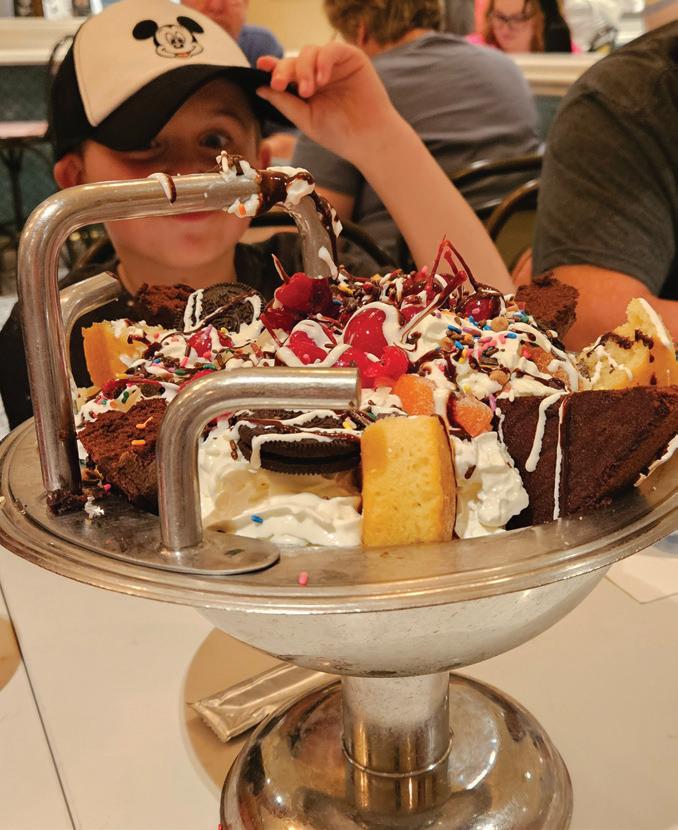
1. Our grandchildren, Cooper, Autumn, and Landon VanScoy, enjoying ice cream at Belle Center Dairy.
— Jeff and Dawn Balser Logan County Electric Cooperative members
2. Our kiddo, James, on vacation in Virginia Beach.
— Sherri Nuttle Holmes-Wayne Electric Cooperative member
3. My husband, James Fox, enjoying a very large ice cream cone from Netty’s in Lakeside Marblehead.
— Janet Fox, Buckeye Rural Electric Cooperative member

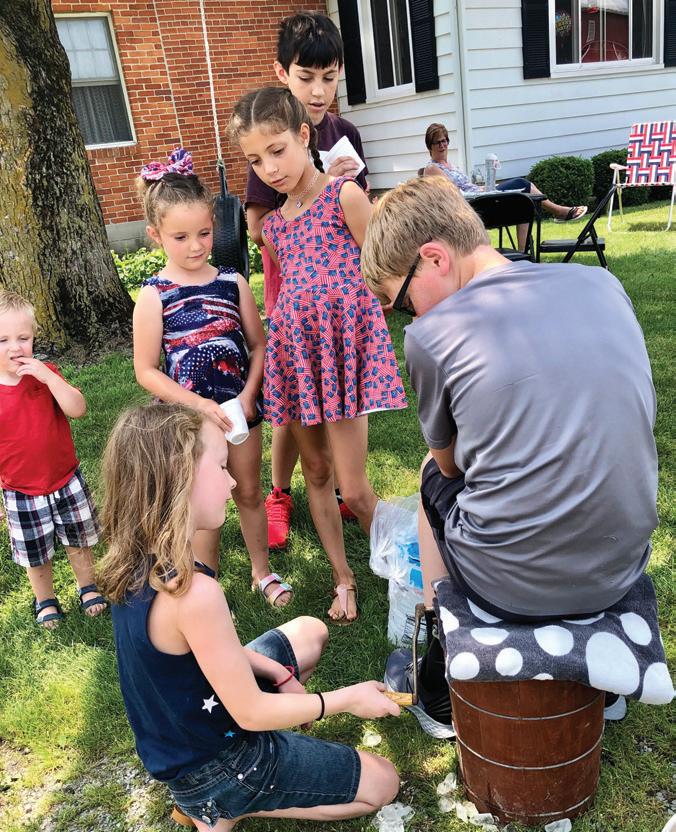
4. Grandson Owen Warnecke enjoying a SpongeBob ice-cream treat on a hot day.
— Della and Kevin Wenninger Paulding Putnam Electric Cooperative members
5. Don’t worry: Our grandson, Woody, had help with his “kitchen sink” ice cream at Walt Disney World.
— Stanley and Patti Ware, Carroll Electric Cooperative members
6. Grandchildren and great-grandchildren making ice cream at my parents’ home.
— Elizabeth McDougle, North Central Electric Cooperative member
For October, send “Fall foliage” by July 15. For November, send “Thanksgiving table” by August 15. Upload your photos at www.ohiocoopliving.com/memberinteractive Your photo may be featured in this magazine or on our website. Send us YOUR picture!



If you hear thunder, you are close enough to get struck by lightning.
Seek shelter indoors:

• Refrain from using corded electrical devices
• Avoid running water, including baths and showers, and stay away from windows
• Stay in shelter until 30 minutes after the last thunder
If you can’t get to shelter:
• Avoid open fields and hilltops

• Stay away from tall, isolated trees and objects
• Spread out from others if you’re in a group



ohioec.org/purpose
